Kennedy's vision, kindness, courage and sacrifice must not be forgotten


 SYDNEY: Just a week after another fatal shark attack in Australia, University of Sydney PhD candidate and shark policy expert Christopher Neff is leading a world-first project to help reduce the public’s fear of sharks.
SYDNEY: Just a week after another fatal shark attack in Australia, University of Sydney PhD candidate and shark policy expert Christopher Neff is leading a world-first project to help reduce the public’s fear of sharks.
 The project, entitled ‘Taking the Bite Out of Jaws: An evidence-based look at public fear of sharks’, is part of the Shark Week activities running until Saturday this week at Sea Life Sydney Aquarium.
The project, entitled ‘Taking the Bite Out of Jaws: An evidence-based look at public fear of sharks’, is part of the Shark Week activities running until Saturday this week at Sea Life Sydney Aquarium.
The research will use 10 iPad touch-screens to survey Aquarium visitors when they enter and exit the Aquarium’s ‘Shark Valley’ exhibit to register their perceptions of sharks after witnessing different science- and conservation-based messages.
“Movies and television have made scaring people about sharks the easy part. This research is trying to find a new way to reduce public fears of sharks,” said Neff.
“This study uses iPads to survey people before and after they walk through an underwater tunnel with sharks swimming over them. We are looking at what messages lower people’s concerns about sharks because this can create more opportunities for shark bite prevention and conservation education.”
Following the week of survey collection, the statistical data will be analysed to seewhich messages are the most effective to reduce fears. Once the results have been reviewed, the survey will be adjusted and the project will be tested at other aquariums around the world.
Shark Week activities at Sea Life Sydney Aquarium are supported by the Sea Life Conservation Fund and the Save Our Seas Foundation.
For other candobetter.net articles on sharks see: the Secret life of sharks by Peter Kimley (book review) and "Jaws 2009, Coming soon to your shores" about how the monster shark in Jaws was actually a metaphor for property developers ruining local democracy and landscape.
 A report released by the Federal Bureau of Infrastructure, Transport and Regional Economics underlines just how inadequate and incompetent Melbourne’s recent planning has been.
A report released by the Federal Bureau of Infrastructure, Transport and Regional Economics underlines just how inadequate and incompetent Melbourne’s recent planning has been.
The report analysed population growth, jobs growth and commuter flows in Australia’s four largest cities. It found:
1) Melbourne was the only city in which jobs growth in the outer suburbs had failed to keep pace with the population boom. Parts of outer Melbourne now have less than one job for every three working people, forcing residents to commute further for employment.
2) Eighty-four per cent of outer Melbournians drive to work, the highest level among Australia’s biggest cities, and just 9% use public transport.
 Monash University Professor of Public Transport Graham Currie said any city growing in population without expanding public transport was planning for decline. He said “the future cupboard of public transport projects is looking bare” and that “If population grows by 25% but services remain essentially static, we have a per capita decline of 25 per cent in service levels. We are not responding to growth. Rather we are going backwards”.
Monash University Professor of Public Transport Graham Currie said any city growing in population without expanding public transport was planning for decline. He said “the future cupboard of public transport projects is looking bare” and that “If population grows by 25% but services remain essentially static, we have a per capita decline of 25 per cent in service levels. We are not responding to growth. Rather we are going backwards”.
This report reveals as a fraud the idea that Melbourne’s rapid population growth is okay. Jobs are far removed from homes, and workers are not using public transport, leading to traffic congestion, long commutes, and reduced quality of life for everybody – a planning debacle.
It’s all very well to say that what is needed is better planning, but expanding the urban growth boundary and high rise and urban consolidation have both given us the outcomes we have today. The better planning never happens, and it won’t as long as Melbourne’s population continues to grow by 200 a day, 1500 a week, 75,000 each year.
Originally published at http://kelvinthomson.blogspot.com.au/2013/11/melbourne-planning-debacle.html
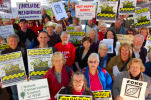 Geoff at Aussiebushtreks writes, "This is very urgent. Please watch Corine Fisher's video. [Inside article]" Then Email upper house pollies without delay. There is still a chance to stop O`Farrells dreadful destructive Planning Law. If you go to http://betterplanningnetwork.good.do/nsw/email-upper-house-mps/ your email will automatically go to Upper House Parliamentarians. Don't dilly dally!
Geoff at Aussiebushtreks writes, "This is very urgent. Please watch Corine Fisher's video. [Inside article]" Then Email upper house pollies without delay. There is still a chance to stop O`Farrells dreadful destructive Planning Law. If you go to http://betterplanningnetwork.good.do/nsw/email-upper-house-mps/ your email will automatically go to Upper House Parliamentarians. Don't dilly dally!
(Video URL is: https://www.youtube.com/watch?v=dJfrSqxpmYY#t=37)
The film tells about the Better Planning Network, which has 115 groups involved, with their numbers rising.
Unlike in the Lower House of Parliament, the NSW Government does not have the majority in the Upper House. Therefore, to ensure that its Planning Bills get through the Upper House, the Government needs the vote of either: Labor; and/or the Greens; and/or the Christian Democrats and the Shooters and Fishers.
The Upper House debate of the Planning Bills could occur as soon as 12 November. It is therefore vital to email Upper House MPs NOW and voice your concerns about the Government's Disgraceful, corrupt and Destructive Planning Bills.
Please write an email in your own words. Some key points you may wish to make are:
The Government's Planning Bills go against its election promise to return planning powers to the local community.
The Government's Planning Bills will not deliver certainty or transparency for communities.
The principle of Ecologically Sustainable Development must be the overarching driver of the legislation.
The ease with which developers will be able to override local councils' planning controls to get their rezoning requests approved by the State, by the issuing of Strategic Compatibility Certificates (a green light to a spot rezoning) goes against the very concept of strategic planning. These provisions must be removed from the Bill.
The restriction of code-assessable development to 'nominated growth areas' will create 2 classes of residents: the first, in low-density suburbs, will have the right to comment on most developments in their neighbourhood; the second, in growth areas, will not.
The Government's Planning Bills do not provide any simpler or more user-friendly a system that the one we already have.
There is no evidence that the Government's Planning Bills will improve housing affordability simply by increasing housing supply. This is because the drivers of housing affordability are complex and include tax (eg. negative gearing) and welfare policies which the Planning Bills will not address.[1]
No amount of tweaking can fix the Bills and it's best to scrap the Bills and work with all stakeholders to draft new legislation.
NOTES
[1] Candobetter Ed.: Less complex but poorly known by the general public is that State governments in Australia drive population growth upward to benefit developers. They do this by encouraging business immigration and family reunion via State websites inviting immigrants. Australia's federal government is in charge of setting a ceiling on total immigration but, since 2009, Australia's population growth has come 60 per cent from extremely high mass immigration. We are talking hundreds of thousands here. See http://candobetter.net/?q=taxonomy/term/5149

Ofcom said Royal Mail was also required to meet a target of 91.5 per cent of next-day delivery for first-class post throughout Britain and not just in densely populated areas.
But it achieved this level in only 62 per cent of the required postcode areas in the year to March 2013.
"Ofcom is concerned about Royal Mail's failure to meet certain service targets," the regulator said, threatening fines if the company continued to deliver late.
Unite, which represents around 7,000 postal managers, said the failures were due to job reductions in the run-up to the firm's privatisation.
Unite Royal Mail officer Brian Scott called for a company-wide review into tackling the issue of staff reductions and overworking.
He said: "Royal Mail has been setting itself up for privatisation in the last year, making unnecessary job reductions and cutting corners to make it a more viable sell-off.
"Members working in delivery offices are under a huge amount of pressure and this continues with no obvious solution."
The Campaign for Public Ownership said it was not just job reductions that were part of the government's preparations for privatisation.
Stamp prices were also increased in the run-up "to turn the people against the company" and to pre-empt an inevitable price rise once investors gained control - which would have resulted in a public backlash.
Campaign director Neil Clark said the future was bleak for the service. He told the Star: "After the next general election the universal service will disappear or mail delivery will take on the heavily subsidised railway model."
A Royal Mail statement said: "We were disappointed that we didn't meet all of the regulatory quality-of-service targets we were required to last year."
 Today I helped a registered nurse to scan documents to submit in a job application. While we were doing this, she mentioned to me with great concern that she had heard that the government is talking about making people work until they are 70 years old and make them take out loans on their homes in order to fund their retirement. "I'm only 46," she said, "but I didn't work when my children were young and I never had the money to save for a home. So I'm supposed to keep on working until I'm 70. I'm too tired now to work full-time because, even though standards are slipping, working conditions are getting tougher and tougher and management more and more unreasonable." The latest productivity report on An Aging Australia supplies policies to undermine the political strength of older people who would otherwise be able to represent the rest of the community and defend the wealth and security basis of the younger generations. Blaming older people for economic decline that has its real seeds in resource decline sets the scene for generational splitting. However, the real targets are actually today's young people and their children.
Today I helped a registered nurse to scan documents to submit in a job application. While we were doing this, she mentioned to me with great concern that she had heard that the government is talking about making people work until they are 70 years old and make them take out loans on their homes in order to fund their retirement. "I'm only 46," she said, "but I didn't work when my children were young and I never had the money to save for a home. So I'm supposed to keep on working until I'm 70. I'm too tired now to work full-time because, even though standards are slipping, working conditions are getting tougher and tougher and management more and more unreasonable." The latest productivity report on An Aging Australia supplies policies to undermine the political strength of older people who would otherwise be able to represent the rest of the community and defend the wealth and security basis of the younger generations. Blaming older people for economic decline that has its real seeds in resource decline sets the scene for generational splitting. However, the real targets are actually today's young people and their children.You would think that in an Australia where the Productivity Commission (see below) is banging on about how health care for an aging population is going to be a huge slice of our economic pie that my friend would be sitting pretty. Not so.

The news about people working until they are 70 years old and being made to sell their houses back to the bank comes from another rather Orwellian report by the Australian Productivity Commission. The Commission seems to want to blame a lot of its suggestions here on the aging population and the costs of health care. (The reference is An Aging Australia, available at this URL: http://www.pc.gov.au/__data/assets/pdf_file/0005/129749/ageing-australia.pdf).
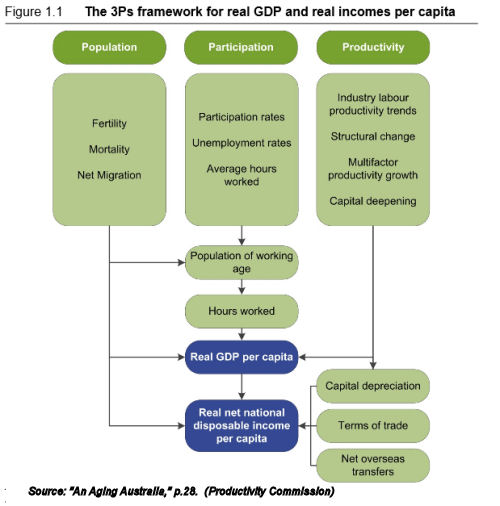
The report has a narrow economic basis whereby GDP = Numbers of Workers X Productivity X Terms of trade. There is no overt consideration of resource depletion, although you can tell it is lurking namelessly. The report presents as an excuse for more population growth, even though it predicts an indefinite (possibly endless) period of economic poverty, when people will have to borrow on their homes to live and work until they drop for declining returns, which it relates vaguely to the end of the mining boom.
"Terms of trade is projected to decline so that, with the additional impacts of contracting growth rates of labour supply and labour productivity, disposable income is projected to grow at a much slower rate compared with the boom period from 1993 to 2012 (figure 7). The bottom line is that the combined cocktail of falling labour supply per capita, a declining terms of trade and poorer productivity growth rates mean that Australians can expect that the growth in disposable income per capita will fall to less than half that of the boom years. A period of truly diminished outcomes is likely to be at hand, unless luck or appropriate policy initiatives intervene. "
In a section entitled "Demography: Net overseas migration", the Report comes clean on what is driving high population growth in Australia: Successive recent governments have pushed very high immigration.
"Unlike either fertility or mortality, [Net Overseas Migration - NOM] is more readily controllable by the Australian Government (DIAC 2013). Most particularly, the Government can set quotas on its migration program [...]."
The report also admits that our extremely high mass immigration is a wild card, although it uses less colourful language:
"Were such levels of [Net Overseas Migration - NOM] to persist over the next 50 years, it would imply a considerably more populous Australia than most population projections."
The section concludes with a sublimely irresponsible comment about why our population might not spiral out of control but somehow stop after 2017 or something like that:
"Typically, advanced countries experience population growth slowdowns as their population numbers rise, and some reversion of Australian population growth rates to the average OECD rate might ultimately be expected," it concludes, blithely.
My comment The Report's faith in Australia experiencing a population growth slowdown to the 'average OECD rate' is dangerously ridiculous in the light of Australia's high immigration. It is presumably relying on 'demographic transition' ideology, which is (a) unreliable and (b) does not take high immigration into account. Australia's population growth was slowing naturally but this natural trend has been completely distorted by State and Federally led mass immigration.[1]
See footnote for full quoted passage.[2]
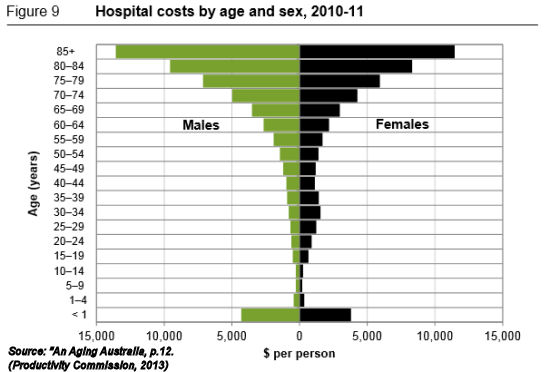
There are some very slanted presentations of the medical costs of aging, notably in a diagram, "Hospital Costs by Age and Sex 2010-2011," which shows a kind of upside-down pyramid with costly old people at its wide top and low cost young people near the narrow base. This gives an apparent cost-weight per elderly person. The casual observer could easily infer from the graph that there were more people over 65 and 85 plus than all the other age-groups in 2011. In fact, due mostly to mass immigration, these numbers will actually be continually bloated, year after year, instead of dying back naturally as the baby-boomers leave their mortal coil.

Mass immigration, discontinued in Western Continental Europe after the first oil shock in 1973, meant that population numbers will decline naturally there as oil declines. In Australian and other Anglophone countries, however, there will be no such gentle and natural decline if artificial population boosting through high immigration is allowed to continue.

The report justifies its presentation of 'trends' in the following statement:
"The apparent neat precision of any particular number is not meant to convey that this shall inevitably be the result, when over a 50 year period a wide variety of unknown factors will arise. But the existence of unknown factors is no basis for not considering the trends, which are the important aspect of this analysis. The trends are unmistakable in most cases."

The problem is that those 'trends' in population, and their proposed solutions in erosion of housing equity and retirement benefits will be taken for gospel by the mass media and parliament. They will be portrayed as inevitable and used to further the corporate agenda, which is to control more and more of Australia's remaining wealth, and allow the majority of citizens less and less control over their material and political circumstances. The very narrow context of this kind of economic report prevents it from recommending citizen empowerment or admitting to resource depletion or inviting comparison with more democratic societies and reconsideration of our legal system. Can the report researchers and writers be criticised for this? Not really; they are working within the same paradigm as the nurses I described at the beginning of this article. It would be career suicide for them to suggest that we are going in the wrong direction with overpopulation and overconsumption.
The Report fails to take into account some enormously influential trends in climate change, overpopulation, oil depletion, loss of democracy (e.g. laws against 'terrorism'), numbers of wars with increasing impact.
It doesn't consider that during the industrial revolution where its life-expectancy charts begin, life expectancy went down to less than half of the ordinary biblical span of three score and ten before it went up again 'due to modern medicine'. And that now diabetes and other nutritional diseases related to our so-called advanced lifestyles and medicine are reducing life expectancy, not increasing it. It does acknowledge a failure to factor those disease risks in, but still merrily uses its projections:
"As the ABS notes, this approach also ignores the possibility of major adverse events, such as major pandemics or wars, though historically these have sometimes been important. Some of these events would be difficult to estimate given their rarity in historical data, and at best, could be treated separately as low probability, high impact events with assumed statistical distributions. For example, the European Actuarial Consultative Group (2006) assesses that there is a high risk of a major global pandemic over a decade, but that events with significant excess population mortality are unlikely. Others doubt that it is possible to make ‘any scientifically based prediction about the emergence of future pandemics ’ (Taubenberger and Morens 2009). Given this, it is more reasonable to take account of other significant risks — such as the possible adverse impacts on longevity of lifestyle factors (growing obesity) and antibiotic resistant bacteria, which would have a gradual effect and could be modelled as a lower - life expectancy scenario in mortality projections. "
In fact, the Report shows what struck me as a wicked sense of humour at times, as if it recognises its own absurdity. On prevention of obesity and other diseases like AIDS, it seems to suggest that dying young might be more economical in the long run:
Second, and more subtly, gauging the effectiveness and efficiency of preventative measures on a disease - by - disease basis can miss the reality that people live to die another day (Bonneux et al. 1998). Dollars saved on avoiding (or minimising the costs) of one disease opens the possibility of people experiencing another costly disease. Ideally, assessments of particular interventions should adopt a longitudinal approach that takes into account the timing and costs of disease and quality of life under the counterfactual that no preventative action is taken.
The Productivity Commission Report "canvasses "policy approaches currently over - the - horizon, but nevertheless relevant to a deeper consideration of the challenges of an ageing Australia (including the role of non - fungible housing equity as a financing method and the link between labour force participation and the Age Pension eligibility age)."
Comment:This report supplies policies to undermine the political strength of older people who would otherwise be able to represent the rest of the community and defend the wealth and security basis of the younger generations. Blaming older people for economic decline that has its real seeds in resource decline sets the scene for generational splitting. The power elites (in the form of banks and corporate government) can then find ways to seize remaining assets and resources in the community for their own enrichment. Young people should realise that this report actually targets their generation - see the huge bulge in the 2014 population pyramid of people below the age of 60. These are the post-baby-boomers. It is their old age that is targeted here. Without land and housing they have no means to grow food, no secure shelter, no security to pass on to their families. The Productivity Commission, with its very narrow parameters of examination, is effectively providing future governments with excuses to make laws to beggar the population. And the Commission is cynically aware of this, implying that young people are stupidly myopic and won't realise that it is their futures that are being targeted, because they cannot imagine being old:
"Despite the possibility of such responses [i.e. protests against giving up their homes], governments can use anti-avoidance measures to reduce the risks of such behaviours at older ages (as it does already with gifting provisions). And responses by the young to possible asset tests when they are old are likely to be relatively weak, reflecting discounting of the future , myopia and the fact that caps would apply to any government - backed equity withdrawal."
Don't you love the term government-backed 'equity withdrawal'? A great new term for the State stealing from its citizens.
On Housing equity: Aim: Put land outside the reach of banks.
To avoid being patsies to these predator policies, Australians need to create new community ownerships with special laws of inheritance for their children, to help relocalise power and organisation in line with families and clans. These are the only secure bases for people in hard times. The British legal model promotes the opposite. If Australia changed its system to Roman Law (the kind used throughout continental Europe) children would be guaranteed to inherit from their parents; shelter and income would be deemed civil rights at law. Another model that amounts to the same thing is the New Zealand Maori land-rights model, which guarantees every Maori descendent land which cannot be sold. Banks should not be able to take shelter and food-gardens from owners or their inheritors. Governments should not be able to legislate water prices out of reach of suburban food producers. Planners should not be able to authorise buildings which block sunlight from gardens and solar panels. People should all have rights to viable land. This is what is missing from this report, which assumes that we will all work for other people and rely on diminishing rations when we can no longer compete with young workers.
The Report trots out the low inflation assertion with which many Australians would disagree:
"The average Australian has nevertheless fared well in the last two decades in terms of net national disposable income per capita, low inflation and low unemployment."
In fact, inflation indicators fail to take into account the very high cost of land for housing, which drives up all other costs. Wages must be high enough for workers to pay the highest accommodation costs in the world and business must pay similar costs for premises, plus wages. Shrinking disposable income has appeared to stretch because of cheap imports from low-wage and low land-cost countries, like China. People have only been able to afford trinkets, however. Whilst rents and mortgages rose, dependence on wages and debt grew. With mass immigration and watering-down of industrial protection, wages and conditions are deteriorating and the cost of finite resources, shelter, food, water and power are inflating.
Conclusion: These trends are the result of government engineering the population to please corporate fancy. If Australians do not start to band together against their corporatised governments these nightmares will come to pass.
Productivity Commission, 22 November, 2013 [3]
"The report examines the effects of ageing on economic output (underpinned by changes in population, participation and productivity) and the resulting implications for government budgets were current policy settings to be maintained.
Key points:
Australia's population will both grow strongly and become older. Such slow but profound shifts in the nature of a society do not elicit the same scrutiny as immediate policy issues. The preferable time to contemplate the implications is while these near inevitable trends are still in their infancy.
Population ageing is largely a positive outcome, primarily reflecting improved life expectancy. A female (male) born in 2012 will on average live for an estimated 94.4 (91.6) years.
However, population growth and ageing will affect labour supply, economic output, infrastructure requirements and governments' budgets.
Australia's population is projected to rise to around 38 million by 2060, or around 15 million more than the population in 2012. Sydney and Melbourne can be expected to grow by around 3 million each over this period.
The population aged 75 or more years is expected to rise by 4 million from 2012 to 2060, increasing from about 6.4 to 14.4 per cent of the population. In 2012, there was roughly one person aged 100 years old or more to every 100 babies. By 2060, it is projected there will be around 25 such centenarians.
Total private and public investment requirements over this 50 year period are estimated to be more than 5 times the cumulative investment made over the last half century, which reveals the importance of an efficient investment environment.
Labour participation rates are expected to fall from around 65 to 60 per cent from 2012 to 2060, and overall labour supply per capita to contract by 5 per cent.
Average labour productivity growth is projected to be around 1.5 per cent per annum from 2012-13, well below the high productivity period from 1988-89 to 2003-04. Real disposable income per capita is expected to grow at 1.1 per cent per annum compared with the average 2.7 per cent annual growth over the last 20 years.
Collectively, it is projected that Australian governments will face additional pressures on their budgets equivalent to around 6 per cent of national GDP by 2060, principally reflecting the growth of expenditure on health, aged care and the Age Pension.
Major impending economic and social changes can create the impetus for new reform approaches not currently on the policy horizon. For example:
The design of the Age Pension and broader retirement income system might be linked to life expectancy after completion of the current transition to 67 years in 2023.
Using some of the annual growth in the housing equity of older Australians could help ensure higher quality options for aged care services and lower fiscal costs.
Wide ranging health care reforms could improve productivity in the sector that is the largest contributor to fiscal pressures. Even modest improvements in this area would reduce fiscal pressures significantly."
26/11/2013: Correction to Stupid mistake about baby-boomers' ages corrected on population-pyramid-2014.jpg. I had them as tweny years older than they are. Apologies. Thanks Jill Quirk of SPA Victoria for pointing this out.
[1] For the latest on demographic theories and which ones hold water, see Sheila Newman, Demography, Territory and Law: The Rules of Animal and Human Populations, Countershock Press, 2013, Chapter 2, "Modern Fertility, Mortality and Development Myths."
[2] An Aging Australia, (Productivity Commission), pp.37-38:
"DEMOGRAPHY
While the technical definition and estimation of net overseas migration (NOM) is complex, it is a measure of long - term arrivals less long - term departures.
NOM has been a critical factor behind Australia’s population growth and will continue to be so (PC 2011 d ).
Unlike either fertility or mortality, NOM is more readily controllable by the Australian Government (DIAC 2013). Most particularly, the Government can set quotas on its migration program — which comprises three categories of migrant (humanitarian, skilled and family re-union). That said, the Australian Government does not have full control over NOM as any number of Australians (and New Zealanders) can arrive or depart. Moreover, the number of temporary entrants, such as long - term visitors and working holiday makers, is effectively uncapped. Their numbers are largely driven by other factors, such as economic conditions. However, since temporary entrants ultimately leave, they do not contribute to long - run population growth.
Currently, NOM is around 230000 per year, which is well above the longer - term average.
From 1948 to 2003, NOM was around 90 000 per year, with no upwards trend. In contrast, in the period 2003 – 2012, the average NOM was around 200000 and the trend growth was around 10000 per year (figure 2.2).
DIAC (2013)forecasts that current high levels of NOM will persist at least until 2017, but that its growth rate will decline. It projects NOM of around 250000 in 2017.
Were such levels of NOM to persist over the next 50 years, it would imply a considerably more populous Australia than most population projections.
It is difficult to establish whether a level of NOM around 200000 – 250000 is likely to persist. In part, the high recent levels may reflect strong relative economic and income growth in Australia c ompared to other countries, which make Australia an attractive destination. Given that the terms of trade are now declining, it is possible that NOM will fall somewhat from its current level.
The contribution of high relative fertility rates and migration means that Australia’s population is growing at a rate well above most OECD countries. Over the period from 1999 to 2010, Australia had the 4th highest population growth rate among OECD countries, with higher growth rates than some less developed economies, such as Mexico and Turkey (OECD 2013). The average growth rate for Australia (1.47 per cent growth per annum) was more than four times that for the 27 European Union countries (0.35 per cent per annum) and more than twice that of the OECD overall (0.68 per cent per annum). The persistence of NOM of 250000 persons per year would underpin continued high growth rates of this order.
Typically, advanced countries experience population growth slowdowns as their population numbers rise, and some reversion of Australian population growth rates to the average OECD rate might ultimately be expected. "
[3] This is a press release from the Productivity Commission about its report.
 People all over the world have been shocked to discover that Mother Agnes Mariam, heroine to many women and men all over the world and peace activist on the ground in Syria, withdrew from speaking at a UK peace conference because two British supposedly 'left-wing' male speakers and journalists - Jeremy Scahill and Owen Jones - threatened to withdraw from speaking if she spoke. Neither speaker has given any substantive explanation for their objections to Mother Agnes, but it seems that both have succumbed to propaganda that the Syrian government of President Bashar al-Assad is brutal and that Agnes Mariam supports the government. This treatment of Mother Agnes Mariam is tragically bizarre, when she has eclipsed professional peace negotiators in so many spheres at once: In her physical bravery in rescuing thousands of people in the war-torn region; as a nun-pacifist woman-leader in the male-dominated politics of church and war; and as a local peace-activist in an internationalised field of jihadists. The article below seeks to highlight just some of these injustices. See links at the end of this article, under "Notes," including a filmed interview with Mother Agnes Mariam done by Susan Dirgham of AMRIS in Australia July 2013.
People all over the world have been shocked to discover that Mother Agnes Mariam, heroine to many women and men all over the world and peace activist on the ground in Syria, withdrew from speaking at a UK peace conference because two British supposedly 'left-wing' male speakers and journalists - Jeremy Scahill and Owen Jones - threatened to withdraw from speaking if she spoke. Neither speaker has given any substantive explanation for their objections to Mother Agnes, but it seems that both have succumbed to propaganda that the Syrian government of President Bashar al-Assad is brutal and that Agnes Mariam supports the government. This treatment of Mother Agnes Mariam is tragically bizarre, when she has eclipsed professional peace negotiators in so many spheres at once: In her physical bravery in rescuing thousands of people in the war-torn region; as a nun-pacifist woman-leader in the male-dominated politics of church and war; and as a local peace-activist in an internationalised field of jihadists. The article below seeks to highlight just some of these injustices. See links at the end of this article, under "Notes," including a filmed interview with Mother Agnes Mariam done by Susan Dirgham of AMRIS in Australia July 2013.
A few weeks ago, following months of siege in a suburb of Damascus, over 5000 civilians were helped to safety during a ceasefire negotiated by Mother Agnes Mariam of the Cross. This suburb of Moadamiya al Sham was one of several around Damascus held by armed rebel groups and foreign jihadists, with the residents trapped there and facing serious food and supply shortages.
Whether these residents were supportive of the 'revolution' - or insurgency - or not, it was in the rebel groups interests to hold them there as 'human shields'; negotiating their release. Movement to the safety of government shelters in Damascus was therefore fraught with difficulties and dangers.

A 'negotiating team' was assembled to go into the heart of rebel territory, led by Mother Agnes - not just figuratively. She went ahead with a white flag, risking her life and faith that a sniper would not put an end to this humanitarian mission. Joined by the rest of the team she then came to a reconciliation and agreement with rebel leaders on the release of some 5,400 people, mostly women and children.
While this was a great success, perhaps more significant was the voluntary surrender of over 500 'rebel fighters', who had clearly been impressed by her entreaties to give up the fight and return to 'fight for Syria', accepting the Government's offer of amnesty.
In her report on the 'rescue of Moadamiya' she emphasises that the Government for its part kept to its word, and faith - that those men who genuinely surrender will not be punished or ill-treated.
/?q=node/3527
It is as though the spirit of reconciliation and peace embodied in Jesus' preachings and actions 2000 years earlier in this land is being reborn, and it is happening through the agency of people of such genuine good will and faith as Mother Agnes. Such a spirit is infectious, and others are inspired to forgive and to reconcile and to trust; this is the spirit now which can heal Syria's dreadful wounds.
The spirit that could heal those wounds .... were it not for the treachery and ill-intent of foreign powers who have already invested so much in destabilising Syrian society and destroying its wealth and infrastructure with their proxy armies of fanatics and mercenaries. The regaining of control by the Syrian government threatens the whole project for regional influence and control that is the driving force behind 'the West's' behaviour over Syria. It is increasingly clear that the West has lost the battle, in the absence of military intervention.
So what should 'We' do? How can the West stop the truth of the last two and a half years emerging? The truth behind the many 'massacres' confected to excuse Western intervention? The truth of Syrians fleeing from rebel 'liberated' areas? ("Liberated from their inhabitants," as Mother Agnes points out.) The truth of the 'Chemical Weapons attack' on Ghouta that nearly brought about a regional war, despite not a single proven victim? ( The OPCW team did no autopsies.)
Perhaps those responsible for the recent denigration of Mother Agnes Mariam were inspired by biblical history, realising that a 'betrayal' from those who would be her supporters could deliver a mortal blow. And so it came to pass that contributors to the Stop the War Peace Conference in the UK refused to share a platform with this true peacemaker.
Have we learned anything in two thousand years?
Related material:
Richard Edmondson, "‘Investigative Journalist’ Scahill Takes Swipe at Mother Agnes" of 17 Nov 2013.
Neil Clark, Mother Agnes and the ‘liberal’ hawks out to silence her of 20 Nov 2013.
Candobetter.net's Mother Agnes Mariam pages.
Mother Agnes Mariam's letter withdrawing from the Stop the War conference (pdf, 66K).
Internet Site of the UK Stop the War Conference.
 What have Penrith Council done to address wild dog problem at the old ADI Site, where environmentalists attempted to resist Lend Lease clearing of wildlife rich, rare Cumberland Woodlands for years? Kangaroos killed by wild dogs metres from new houses at Jordan Springs. Lend Lease have been licenced by the NSW Environment Minister to manage the remnant Kangaroo population which is now contained within the proposed 900 ha Wianamatta Regional Park.
What have Penrith Council done to address wild dog problem at the old ADI Site, where environmentalists attempted to resist Lend Lease clearing of wildlife rich, rare Cumberland Woodlands for years? Kangaroos killed by wild dogs metres from new houses at Jordan Springs. Lend Lease have been licenced by the NSW Environment Minister to manage the remnant Kangaroo population which is now contained within the proposed 900 ha Wianamatta Regional Park.
Western Sydney Conservation Alliance Inc
20th November 2013

The last remaining Kangaroos and Emus at the old ADI Site in Penrith are under attack from wild dogs with recent photo evidence showing one such attack on a large male Kangaroo took place only metres from new houses being developed by property giant Lend Lease. Lend Lease have been licenced by the NSW Environment Minister to manage the remnant Kangaroo population which is now contained within the proposed 900 ha Wianamatta Regional Park. The proposed Regional Park adjoins the Lend Lease housing development. Lend Lease, the NSW National Parks and Wildlife Service and Penrith Council have known of the the wild dog problem on the ADI Site for many years.
In February this year when Emus were escaping from the ADI Site and wandering the streets of Penrith a report came before Penrith Council on the issue of Lend Leases macrofauna management practices. A WSCA member addressed the Council meeting and raised the issue of wild dogs hunting Kangaroos and Emus. Council at the time resolved to write to Lend Lease, National Parks and Wildlife and Robyn Parker the NSW Environment Minister about feral animal management. http://bizsearch.penrithcity.nsw.gov.au/pccbps/Open/2013/CNL_04022013_MIN_WEB.HTM
“The fact that Kangaroos are being killed by dogs metres from new houses at Jordan Springs nine months after Penrith Council resolved to do something about the issue tells us that Penrith Council has failed to take this matter seriously. If a large male Kangaroo can be killed by dogs at the site so could a child. This is not just a matter of environmental destruction this is a matter of public health and safety involving the residents of Penrith. That risk is real as photo evidence shows Lend Lease are failing to maintain fencing between the houses and the proposed Regional Park”.

“The Jordan Springs development, supported by Penrith Council, has been an environmental and social disaster with hundreds of hectares of critically endangered Cumberland Plain Woodland turned to moonscape and our local roads in chaos due to traffic congestion and road works. And now Penrith Council is doing nothing to stop the poor old Kangaroos, that once called Jordan Springs home, being decimated by wild dogs.”
“Council must finally act on this matter and stop being a cheer leader for Lend Lease. Council is fully aware that Lend Lease and Robyn Parker the NSW Environment Minister have legal responsibilities for the welfare of Kangaroos of Emus at the ADI Site and to have a feral animal management plan in place to control animals such as dogs.”
Macrofauna reduction program and wild dogs
“In granting development zonings to Lend Lease over ten years ago the NSW Government required them to develop and implement a feral animal reduction program. This clearly is not happening as wild dogs have been on the site for years. The NSW Government also required Lend Lease to implement a Macrofauna population reduction program – a program meant to be overseen by the NSW Environment Minister. Lend Lease has spent millions of dollars on a sterilisation program and it is feared they are turning a blind eye to the wild dogs because the dogs are assisting them to quickly bring down the Kangaroo numbers.”
“Penrith Council, the NSW Government and Lend Lease appear complicit in this further attack on western Sydney's dwindling populations of macro fauna.”
Geoff Brown
President
Western Sydney Conservation Alliance Inc
0431 222602

Bled dry - the fate of greyhound racing's 'wastage'
7.30 recently exposed widespread doping in the greyhound racing industry, and since then they've had a huge response.
Greyhound racing is an industry that a lot of people enjoy, but behind it lies a terrible toll on the dogs. There's a massive toll of injured animals. Many exhibit crate and muzzle sores, and stress from high speed chases. Australia's greyhound industry is the third biggest in the world, and each year Australians wager about $3 billion on the sport.
The ABC has received thousands of emails, calls and Facebook posts, some from insiders who've raised more concerns about the industry, others who claim we didn't show the positive aspects of their sport.
ABC: 7.30 report">Bled dry - the fate of greyhound racing's 'wastage'
In the past year more than 70 dogs have tested positive to banned substances, but insiders say many more cheats go undetected and use popular drugs including cocaine, amphetamines, caffeine and EPO, the performance-enhancing hormone favoured by disgraced cyclist Lance Armstrong.
The greyhounds who do make it to the track may endure harsh training regimes and are put at significant risk of sustaining serious injuries, such as broken legs, paralysis or head trauma, during training and racing. Some even die from cardiac arrest due to the extreme physical intensity of racing. On many occasions the injuries are 'uneconomical' to treat and the owner will instead have the dog killed.
They will finish racing between the ages of 2 and 4. Of the chosen dogs only about half reach naming and training age. Thousands of puppies and young dogs are routinely killed. The racing industry use the euphemism that they are "humanely euthanased", or kept by their owners or adopted as pets. The grim reality is that campaigners believe that 20,000 dogs are slaughtered every year.
Many retired greyhounds are dumped, used for medical research or bled to death for their blood. In a macabre irony, unwanted and dying greyhounds are being drained of their blood to help with the treatment of other dogs! It's like "farming" spare body parts, from third world impoverished countries, and risking the lives of the "donors" or killing them, for the benefit of the wealthy. It's predatory as is assumed that greyhounds, being part of an "industry" rather than pets, have less intrinsic value.
7.30 Report has exposed widespread doping of the racing dogs, but even more saddening and grotesque is that veterinary nurses claim they are being forced to kill some of the 17,000 healthy greyhound dogs believed to be discarded by the industry each year.
SELENA COTTRELL-DORMER, VETERINARY NURSE: You get eight dogs dropped off, oftentimes they will be just, yeah, just absolutely bled to death and euthanased, put in a body bag and put in the freezer and taken away for incineration. That's absolutely routine. No-one would bat an eyelid at that being the reality.
VICTORIA LUXTON-BAIN, VETERINARY NURSE: They would be brought in by a trainer. Normally we would get about three or four dogs and then they would arrive and then they'd be bled within about 48 hours of arriving. So they'd be put under anaesthetic and then bled and then euthanased while under anaesthetic.
Animals and entertainment/gambling industries are not compatible, and inevitably lead to exploitation. The greyhound racing industry cruelly adds to our already abysmal pool of unwanted animals, doomed for "death row".
Like the horse racing industry's over-breeding and high rates of disposals, each year thousands of dogs never make it to the track because they fail to chase - or simply aren't fast enough. They then become "wastage" and end up being destroyed.
The Australian greyhound racing industry exports hundreds of greyhounds to supply and stimulate racing industries in other countries, where most of them will also be killed after their racing days. One of the biggest markets is Macau, — where the Canidrome racing track does not allow any dogs to be adopted.
Greyhound racing has been recognised as a cruel sport and therefore banned in 6 states of the USA and also in South Africa, with growing opposition in other countries. Australia's standard as a first-world country, with humane treatment of animals, is failing to give these dogs a "fair go".
This "sport" that uses, consumes and disposes of dogs in a wholesale manner and needs to be banned, like blood sports.
Greyhounds maybe fast, but they don't need much exercise. They are naturally docile and gentle dogs and given the chance they make loving and faithful companions.
 "I, and every other post-war baby boomer, can count myself incredibly lucky to be born when I was, because our children do not have the opportunities my generation had—job and career opportunities, housing opportunities and free education. For all the hype about growth and progress and development building a better world, it is not. It is tougher for our kids than it ever was for us." (Kelvin Thomson Thursday, 14 November 2013, House of Reps Chamber Speech)
"I, and every other post-war baby boomer, can count myself incredibly lucky to be born when I was, because our children do not have the opportunities my generation had—job and career opportunities, housing opportunities and free education. For all the hype about growth and progress and development building a better world, it is not. It is tougher for our kids than it ever was for us." (Kelvin Thomson Thursday, 14 November 2013, House of Reps Chamber Speech)
(Candobetter recommends that you start this video at 2.25 minutes in for the guts of population and planning democracy. Note that in this speech, Thomson refers to his new NGO, Victoria First, but this reference does not seem to be in the proofed Hansard.)
[1]
Recently, I read a thorough and detailed book written by His Royal Highness the Prince of Wales. It is called Harmony.
My copy was given to me by Dick Smith. Dick is an outstanding Australian who cares deeply for this country. Dick's work on issues like population and Australian ownership is inspirational for me and, I know, many others.
I absolutely commend Prince Charles's book, Harmony to everyone who is interested in the future of our planet. The breadth of his knowledge is exceptional, and both the intellectual rigour and creative insight lying behind this book are deeply impressive. There is way too much about environment, population, food and architecture in it for me to do justice to it here.
You will have to read it for yourselves. But I will give two examples.
Let me cite first page 220, where he discusses academic studies which have found that contact with nature can make people more resilient to illness. One piece of research investigates the recovery rates of patients who had access to a view of trees in a Texas hospital courtyard, compared with those whose windows gave sight of only a concrete wall.
All the patients had undergone the same gall bladder surgery, so were considered to be a broadly comparable group. Those patients who enjoyed a view of trees out the window spent fewer days in hospital, used fewer narcotic drugs, had fewer complications and registered fewer complaints with nurses responsible for their care.
By contrast, the people who could not see images of nature suffered increased depression, were in need of more pain relief and spent more time in recovery. So being exposed to the patterns produced by nature is directly necessary for our health. Prince Charles says the findings underline how harmony and connection with nature is not some vague or fringe concern but has real benefits for people.
The second example I will draw to attention of the House is on page 232, where he bemoans 'the modern trend towards more and more central planning'. He says:
Communities get what others decide for them—there are no alternatives on offer. ...
A top-down approach to planning has been something of a partner of the industrial-scale copybook urban scheme. It is driven by the brutal economics of 'growth' and competitiveness and the pursuit of efficiency targets that care little as to whether a place ends up with 'soul'.
But Prince Charles believes that if people are empowered to work together there are huge benefits.
He says:
"... the ability of people to self organise can be a very powerful force, but sadly it is an opportunity that is too often untapped. Centralised spatial planning devised by specialist planners trained in a 20th century mechanistic ideology sometimes misses fundamental choices and can lead communities in directions that are not in their best interests. I have enough experience now to know for sure that if people had been put more at the heart of the planning process, some of the disastrous urban environments created in many cities during the twentieth century might easily have been avoided."
I personally think it incredibly important that local residents get to determine what kind of street, neighbourhood and community they live in. And I will provide some free political advice to any of the new MPs in this place who decided parliament is all right and that they would prefer a lengthy parliamentary career to a brief one: back local residents, not property developers. I repeat: support local residents, not property developers.
I was not a candidate for the opposition front bench.
I was a shadow minister for 10 years prior to 2007. I have been there and done that. It is my experience that being a shadow minister brings with it obligations not to speak outside your portfolio, and to have everything you do say cleared and approved by the Leader of the Opposition's office. For me, these limitations are simply too great in a world and an Australia that I believe is facing massive challenges.
The world is being damaged, perhaps irreparably, by rapid population growth, climate change, unchecked rainforest and other habitat destruction, poverty, war and terrorism. Australia is not immune from these challenges. Many of our unique and beautiful birds, plants and animals are on the brink of extinction. Our young people cannot afford to buy a home of their own, and their jobs are insecure, while pensioners and retirees battle rapidly rising electricity, gas and water bills and council rates.
I need to be able to speak out about these things, and I intend to. Anyone who thinks my decision to return to the back bench means that I am looking to lead a quiet life and slip out the back door is very mistaken. On the contrary, it is a necessary pre-condition for being active in the debate about the issues that are of greatest importance to the world and to this country.
I, and every other post-war baby boomer, can count myself incredibly lucky to be born when I was, because our children do not have the opportunities my generation had—job and career opportunities, housing opportunities and free education. For all the hype about growth and progress and development building a better world, it is not. It is tougher for our kids than it ever was for us.
This is not just true for Australia. It is true in many other countries as well. It is heartbreaking to hear the stories of all the African migrants who drowned off the coast of the Mediterranean island of Lampedusa.
Terrible, terrible, terrible. There is a response that says we should tackle this problem by dismantling our borders and allowing people to live wherever they want to live. But anyone who has seen the Gumballs video, by Roy Beck of NumbersUSA—and if you have not, I cannot recommend it too highly—will know that there are two billion people in the world living on $2 per day or less, and that their numbers are increasing by 80 million every year. No nation in the world—not the United States, not Europe, not Australia—can cope with such numbers.
There are two causes of mass migration. One is people fleeing political violence and repression. The other driver is poverty and people wanting a better life. In those countries that are beset by political violence, the most common cause is religious fundamentalism.
There is religious violence, oppression of minorities, not enough respect for the rights of women, and not enough separation between religion and politics and between church and state. This needs to be called out.
It is a task for all of us, from whatever religious or ethnic background we come, to condemn, to denounce, to shun and to treat as outcasts religious leaders who preach hate and violence. It has to be called for what it is. Until political and religious violence stops, there will be people fleeing it.
Of the other motive for getting on board a boat—the search for a better life—again, we all have a role to play. We should lift our foreign aid budget to 0.7 per cent of GDP. We should not cut our aid by $4.5 billion over the forward estimates as the Liberal government is doing. It is claimed there is a budget emergency and we cannot afford this aid. Why then is the defence budget to be increased? The government target of 2 per cent of GDP spending on defence is quite arbitrary, and absolute nonsense. Spending money on aid builds goodwill with our neighbours and makes us more secure. I have seen it with my own eyes—the people in Wills.
In my view, honourable defeat is overrated. In my view there is little honour in avoidable failure. In my view those who want to save the environment, those who want to help workers and those who care about the future have a responsibility to succeed. Honour comes from success, from solving problems, from being able to proudly hand the baton over to the next generation.
In political debate people are very frightened about being called racist or xenophobic. This is true of prime ministers and it is true of ordinary people. Yes, there are racists out there. It is a pity; it is true.
But the use of the term 'racism' has become a new kind of McCarthyism, used to stifle debate. Let me point out in response to the allegation of racism or xenophobia against people who want to contest our rapid population growth that, first, Australia is already a multiracial society—one-quarter born oversees, one-half with one or both parents born overseas. The bird has flown. No-one is trying to maintain Australia as a white Anglo Saxon outpost of the British empire. It cannot be done and I have not come across anyone who is trying.
Secondly, stopping rapid population growth will assist Australians of all backgrounds. For example, Broadmeadows has high unemployment. Many unemployed people in Broadmeadows are of Turkish background. They are entitled to our consideration, rather than running migrant worker programs that wreck their ability to find work.
Thirdly, if talking about population makes you a racist, you are in pretty good company.
People do not usually think of Dr Martin Luther King as a white supremacist. What did he have to say about population?
"Family planning, to relate population to world resources, is possible, practical and necessary. Unlike plagues of the dark ages or contemporary diseases we do not yet understand, the modern plague of overpopulation is soluble by means we have discovered and with resources we possess.
What is lacking is not sufficient knowledge of the solution but universal consciousness of the gravity of the problem and education of the billions who are its victims.
People would not ordinarily think of David Suzuki as a puppet or fellow traveller of Pauline Hanson. What did he have to say about population?
Dr Suzuki said:
Of course human numbers are at the very core of our crisis. The explosive rate of growth simply can't continue.
And, while we are at it, I will point out a couple more.
In 1993, former US President Bill Clinton told the United Nations:
"And to ensure a healthier and more abundant world, we simply must slow the world's explosive growth in population."
His vice-president, Al Gore, said:
"I consider the dramatic growth in the world's population to be the greatest challenge currently facing the environment ... The effects of this rapid increase are felt around the globe."
It is ironic in the extreme that we have a couple of agents provocateur out there accusing people who talk about population of trying to hijack the environmental movement when, in fact, they are the most fair dinkum environmentalists you will find. I defy anyone to challenge the environmental credentials of Jacques Cousteau, who has devoted his entire life to marine conservation, and who said:
"Population growth is the primary source of environmental damage."
I defy anyone to challenge the environmental credentials of Captain Paul Watson, the founder of Sea Shepherd Conservation Society, who has spent his life risking injury and imprisonment to harass Japanese whalers. He said:
"The accusation that a stand to reduce immigration is racist is music to the ears to those who profit from the cheap labor of immigrants. They are the same people who love to see environmentalists make fools of themselves. And there is no environmentalist more foolish than one who refuses to confront the fact that uncontrolled human population growth is the no. 1 cause of the world's increasing environmental problems."
[1] Thursday, 14 November 2013
HOUSE OF REPRESENTATIVES CHAMBER SPEECH
It's interesting that we now have a Shadow Treasurer, the previous minister for Immigration under Labor, commenting on the blowout of the housing bubble, who is seeing the evidence of high rates of immigration - and loose borders that allow foreign investors to strangle the real estate market.
Economist Saul Eslake, a member of the National Housing Supply Council, said vested interests from property owners and politicians meant policies that could support first home buyers - such as the abolishment of negative gearing and lower costs for new developments - were unlikely to ever see the light of day. The housing Ponzi scheme is being driven and manipulated by investors, who create and guarantee their portfolios delivered by high rates of population growth and heavy support for domestic and foreign investors.
Booming housing market leaves first home buyers behind, says Chris Bowen by Glenda Kwek and Simon Johanson in the Melbourne Age of 16 Nov 2013.
All Ponzi schemes eventually collapse. Back in February 2012, Deakin University’s Philip Soos said that the only thing that prevented Australian house prices from crashing during the 2008 GFC was the first-home owners’ boost, who believes the sector is now operating like a Ponzi scheme. According to Soos, the tipping point for the mark will come when “the household sector is so overloaded with debt there exist no more ‘greater fools’ willing to commit to a lifetime of debt serfdom to purchase property”.
See Australian housing a Ponzi scheme and the housing bubble will burst by Larry Schlesinger in the Property News of 7 February 2012.
Sooner or later you run out of unsuspecting new investors and the whole thing collapses.
The end of the housing bubble will hurt our economy, but it's time to make the transition to a real and productive economy, rather than the predatory one of mortgages, accumulating more and more potential buyers (victims) into the scheme, and the strangle-hold property developers.
 Highlighting the hypocrisy and double standards of Australia's official 'commitment' to the 'war on terror' in Afghanistan, and the celebration of the 'heroic sacrifices' made there by Australian soldiers on Remembrance day, was the appearance in our media of a video clip from Syria the following day.
Highlighting the hypocrisy and double standards of Australia's official 'commitment' to the 'war on terror' in Afghanistan, and the celebration of the 'heroic sacrifices' made there by Australian soldiers on Remembrance day, was the appearance in our media of a video clip from Syria the following day.
This video, from the studios of the 'Al Qaeda linked group' Jabhat al Nusra, showed the last minutes before the martyrdom of 'Abu Asma al Australi', as he drove an explosives packed truck towards a military checkpoint at an airport in Deir al Zour, in Syria's north-east. In the video 'Abu Asma's' face was fuzzed out, though we could see a bushy beard and a stocky physique. He delivered a propaganda message of encouragement to Muslims everywhere to take up the Jihad in Syria, and make the ultimate sacrifice.
 While this man was known to Australian authorities, - allegedly 'Ahmad' from Logan near Brisbane - and belonged to a community there which supports 'the jihad' against the Assad government, his family claims he never went to Syria to fight, and is alive and well and living in Turkey. They also claim that he didn't speak Arabic like the man shown in the video ....
While this man was known to Australian authorities, - allegedly 'Ahmad' from Logan near Brisbane - and belonged to a community there which supports 'the jihad' against the Assad government, his family claims he never went to Syria to fight, and is alive and well and living in Turkey. They also claim that he didn't speak Arabic like the man shown in the video ....
But these are details; the intent was there, and the 'operation' supported by Australian supporters of the insurgency or jihad if you prefer. Our concern should be whether this support extends beyond Ahmad's community, and whether allowance is being made for Australia's first suicide bomber because he was striking an 'approved target'?
Although our media may not be strictly government operated, the man who pays the piper calls the tune; the language used to describe this terrorist atrocity tells us the story. Nowhere is there mention in the ABC report on this video of 'terrorist' or 'war crime' - we have only 'jihadist', and 'hard-line group'. But worse by far than this, we are never told about 'the target' of 'the operation'. A TV reporter referred to 'people' killed, but honourably corrected himself with 'government soldiers', but failed to say how many.

The truth is shocking.
This one Australian 'hero' ( as he is regarded now as a martyr) on one day killed as many Syrian soldiers as those of our Australian 'heroes' who have been killed in Afghanistan in a decade. Thirty five Syrian soldiers were obliterated by 'Abu Asma al Australi's' truck bomb; ordinary men with families, mothers, wives, sons, fathers. Men fighting to save their nation from a foreign invasion of barbarians and fundamentalist psychopaths; fighting to protect their neighbours and communities from random acts of violence, and save their country from the malign foreign powers who slash and burn what they have failed to seduce.
An estimated 27,000 Syrian soldiers have now died protecting their country, many as a result of similar bombings; along with a further 15,000 militia members fighting on the government side, they constitute the largest group of casualties in the total death toll of around 115,000.
ABC report from M/E correspondent Matt Brown with video link:
http://www.abc.net.au/am/content/2013/s3888818.htm
 In Costa Rica, publicly-owned banks have been available for so long and work so well that people take for granted that any country that knows how to run an economy has a public banking option. Costa Ricans are amazed to hear there is only one public depository bank in the United States (the Bank of North Dakota), and few people have private access to it.
In Costa Rica, publicly-owned banks have been available for so long and work so well that people take for granted that any country that knows how to run an economy has a public banking option. Costa Ricans are amazed to hear there is only one public depository bank in the United States (the Bank of North Dakota), and few people have private access to it. So says political activist Scott Bidstrup, who writes:
So says political activist Scott Bidstrup, who writes:
"For the last decade, I have resided in Costa Rica, where we have had a "Public Option" for the last 64 years. There are 29 licensed banks, mutual associations and credit unions in Costa Rica , of which four were established as national, publicly-owned banks in 1949. They have remained open and in public hands ever since--in spite of enormous pressure by the I.M.F. [International Monetary Fund] and the U.S. to privatize them along with other public assets. The Costa Ricans have resisted that pressure--because the value of a public banking option has become abundantly clear to everyone in this country.
During the last three decades, countless private banks, mutual associations (a kind of Savings and Loan) and credit unions have come and gone, and depositors in them have inevitably lost most of the value of their accounts.
But the four state banks, which compete fiercely with each other, just go on and on. Because they are stable and none have failed in 31 years, most Costa Ricans have moved the bulk of their money into them. Those four banks now account for fully 80% of all retail deposits in Costa Rica, and the 25 private institutions share among themselves the rest."
According to a 2003 report by the World Bank, the public sector banks dominating Costa Rica's onshore banking system include three state-owned commercial banks (Banco Nacional, Banco de Costa Rica, and Banco Crédito Agr-cola de Cartago ) and a special-charter bank called Banco Popular, which in principle is owned by all Costa Rican workers. These banks accounted for 75 percent of total banking deposits in 2003.
In Competition Policies in Emerging Economies: Lessons and Challenges from Central America and Mexico (2008), Claudia Schatan writes that Costa Rica nationalized all of its banks and imposed a monopoly on deposits in 1949. Effectively, only state-owned banks existed in the country after that. The monopoly was loosened in the 1980s and was eliminated in 1995. But the extensive network of branches developed by the public banks and the existence of an unlimited state guarantee on their deposits has made Costa Rica the only country in the region in which public banking clearly predominates.
Scott Bidstrup comments:
"By 1980, the Costa Rican economy had grown to the point where it was by far the richest nation in Latin America in per-capita terms. It was so much richer than its neighbors that Latin American economic statistics were routinely quoted with and without Costa Rica included. Growth rates were in the double digits for a generation and a half. And the prosperity was broadly shared. Costa Rica 's middle class - nonexistent before 1949 - became the dominant part of the economy during this period. Poverty was all but abolished, favelas [shanty towns] disappeared, and the economy was booming."
This was not because Costa Rica had natural resources or other natural advantages over its neighbors. To the contrary, says Bidstrup:
"At the conclusion of the civil war of 1948 (which was brought on by the desperate social conditions of the masses), Costa Rica was desperately poor, the poorest nation in the hemisphere, as it had been since the Spanish Conquest.
The winner of the 1948 civil war, José "Pepe" Figueres, now a national hero, realized that it would happen again if nothing was done to relieve the crushing poverty and deprivation of the rural population. He formulated a plan in which the public sector would be financed by profits from state-owned enterprises, and the private sector would be financed by state banking.
A large number of state-owned capitalist enterprises were founded. Their profits were returned to the national treasury, and they financed dozens of major infrastructure projects. At one point, more than 240 state-owned corporations were providing so much money that Costa Rica was building infrastructure like mad and financing it largely with cash. Yet it still had the lowest taxes in the region, and it could still afford to spend 30% of its national income on health and education.
A provision of the Figueres constitution guaranteed a job to anyone who wanted one. At one point, 42% of the working population of Costa Rica was working for the government directly or in one of the state-owned corporations. Most of the rest of the economy not involved in the coffee trade was working for small mom-and-pop companies that were suppliers to the larger state-owned firms--and it was state banking, offering credit on favorable terms, that made the founding and growth of those small firms possible. Had they been forced to rely on private-sector banking, few of them would have been able to obtain the financing needed to become established and prosperous. State banking was key to the private sector growth. Lending policy was government policy and was designed to facilitate national development, not bankers' wallets. Virtually everything the country needed was locally produced. Toilets, window glass, cement, rebar, roofing materials, window and door joinery, wire and cable, all were made by state-owned capitalist enterprises, most of them quite profitable. Costa Rica was the dominant player regionally in most consumer products and was on the move internationally."
Needless to say, this good example did not sit well with foreign business interests. It earned Figueres two coup attempts and one attempted assassination. He responded by abolishing the military (except for the Coast Guard), leaving even more revenues for social services and infrastructure.
When attempted coups and assassination failed, says Bidstrup, Costa Rica was brought down with a form of economic warfare called the "currency crisis" of 1982. Over just a few months, the cost of financing its external debt went from 3% to extremely high variable rates (27% at one point). As a result, along with every other Latin American country, Costa Rica was facing default. Bidstrup writes:
"That's when the IMF and World Bank came to town.
Privatize everything in sight, we were told. We had little choice, so we did. End your employment guarantee, we were told. So we did. Open your markets to foreign competition, we were told. So we did. Most of the former state-owned firms were sold off, mostly to foreign corporations. Many ended up shut down in a short time by foreigners who didn't know how to run them, and unemployment appeared (and with it, poverty and crime) for the first time in a decade. Many of the local firms went broke or sold out quickly in the face of ruinous foreign competition. Very little of Costa Rica 's manufacturing economy is still locally owned. And so now, instead of earning forex [foreign exchange] through exporting locally produced goods and retaining profits locally, these firms are now forex liabilities, expatriating their profits and earning relatively little through exports. Costa Ricans now darkly joke that their economy is a wholly-owned subsidiary of the United States."
The dire effects of the IMF's austerity measures were confirmed in a 1993 book excerpt by Karen Hansen-Kuhn titled Structural Adjustment in Costa Rica: Sapping the Economy. She noted that Costa Rica stood out in Central America because of its near half-century history of stable democracy and well-functioning government, featuring the region's largest middle class and the absence of both an army and a guerrilla movement. Eliminating the military allowed the government to support a Scandinavian-type social-welfare system that still provides free health care and education, and has helped produce the lowest infant mortality rate and highest average life expectancy in all of Central America.
In the 1970s, however, the country fell into debt when coffee and other commodity prices suddenly fell, and oil prices shot up. To get the dollars to buy oil, Costa Rica had to resort to foreign borrowing; and in 1980, the U.S. Federal Reserve under Paul Volcker raised interest rates to unprecedented levels.
In The Gods of Money (2009), William Engdahl fills in the back story. In 1971, Richard Nixon took the U.S. dollar off the gold standard, causing it to drop precipitously in international markets. In 1972, US Secretary of State Henry Kissinger and President Nixon had a clandestine meeting with the Shah of Iran. In 1973, a group of powerful financiers and politicians met secretly in Sweden and discussed effectively "backing" the dollar with oil. An arrangement was then finalized in which the oil-producing countries of OPEC would sell their oil only in U.S. dollars. The quid pro quo was military protection and a strategic boost in oil prices. The dollars would wind up in Wall Street and London banks, where they would fund the burgeoning U.S. debt. In 1974, an oil embargo conveniently caused the price of oil to quadruple. Countries without sufficient dollar reserves had to borrow from Wall Street and London banks to buy the oil they needed. Increased costs then drove up prices worldwide.
By late 1981, says Hansen-Kuhn, Costa Rica had one of the world's highest levels of debt per capita, with debt-service payments amounting to 60 percent of export earnings. When the government had to choose between defending its stellar social-service system or bowing to its creditors, it chose the social services. It suspended debt payments to nearly all its creditors, predominately commercial banks. But that left it without foreign exchange. That was when it resorted to borrowing from the World Bank and IMF, which imposed "austerity measures" as a required condition. The result was to increase poverty levels dramatically.
Bidstrup writes of subsequent developments:
"Indebted to the IMF, the Costa Rican government had to sell off its state-owned enterprises, depriving it of most of its revenue, and the country has since been forced to eat its seed corn. No major infrastructure projects have been conceived and built to completion out of tax revenues, and maintenance of existing infrastructure built during that era must wait in line for funding, with predictable results.
About every year, there has been a closure of one of the private banks or major savings co-ops. In every case, there has been a corruption or embezzlement scandal, proving the old saying that the best way to rob a bank is to own one. This is why about 80% of retail deposits in Costa Rica are now held by the four state banks. They're trusted.
Costa Rica still has a robust economy, and is much less affected by the vicissitudes of rising and falling international economic tides than enterprises in neighboring countries, because local businesses can get money when they need it. During the credit freezeup of 2009, things went on in Costa Rica pretty much as normal. Yes, there was a contraction in the economy, mostly as a result of a huge drop in foreign tourism, but it would have been far worse if local business had not been able to obtain financing when it was needed. It was available because most lending activity is set by government policy, not by a local banker's fear index.
Stability of the local economy is one of the reasons that Costa Rica has never had much difficulty in attracting direct foreign investment, and is still the leader in the region in that regard. And it is clear to me that state banking is one of the principal reasons why.
The value and importance of a public banking sector to the overall stability and health of an economy has been well proven by the Costa Rican experience. Meanwhile, our neighbors, with their fully privatized banking systems have, de facto, encouraged people to keep their money in Mattress First National, and as a result, the financial sectors in neighboring countries have not prospered. Here, they have--because most money is kept in banks that carry the full faith and credit of the Republic of Costa Rica, so the money is in the banks and available for lending. While our neighbors' financial systems lurch from crisis to crisis, and suffer frequent resulting bank failures, the Costa Rican public system just keeps chugging along. And so does the Costa Rican economy."
He concludes:
"My dream scenario for any third world country wishing to develop, is to do exactly what Costa Rica did so successfully for so many years. Invest in the Holy Trinity of national development--health, education and infrastructure. Pay for it with the earnings of state capitalist enterprises that are profitable because they are protected from ruinous foreign competition; and help out local private enterprise get started and grow, and become major exporters, with stable state-owned banks that prioritize national development over making bankers rich. It worked well for Costa Rica for a generation and a half. It can work for any other country as well. Including the United States."
The new Happy Planet Index, which rates countries based on how many long and happy lives they produce per unit of environmental output, has ranked Costa Rica #1 globally. The Costa Rican model is particularly instructive at a time when US citizens are groaning under the twin burdens of taxes and increased health insurance costs. Like the Costa Ricans, we could reduce taxes while increasing social services and rebuilding infrastructure, if we were to allow the government to make some money itself; and a giant first step would be for it to establish some publicly-owned banks.
Original source was: OpEdNews Op Eds 11/12/2013 at 12:32:55
About the Author: Ellen Brown is an attorney, president of the Public Banking Institute, and author of 12 books, including WEB OF DEBT and its newly-released sequel, THE PUBLIC BANK SOLUTION. Her websites are http://WebofDebt.com, http://PublicBankSolution.com, and http://PublicBankingInstitute.org.


 Bunyip animal rescue network (BARN) is having a speaker meeting to raise funds. All welcome. Guests are Barrie Tapp, Animal Cruelty investigator and Nigel Williamson, Animal rescuer on 1st December 2013. They are taking donations for wildlife recovery after NSW bushfires.
Bunyip animal rescue network (BARN) is having a speaker meeting to raise funds. All welcome. Guests are Barrie Tapp, Animal Cruelty investigator and Nigel Williamson, Animal rescuer on 1st December 2013. They are taking donations for wildlife recovery after NSW bushfires.
 Barrie Tapp, Animal Cruelty Investigator will talk about different types of animal cruelty, and how various cases are dealt with… and he will answer animal cruelty questions.
Barrie Tapp, Animal Cruelty Investigator will talk about different types of animal cruelty, and how various cases are dealt with… and he will answer animal cruelty questions.
 Nigel Williamson, Animal Rescuer, will talk about his animal rescue business and will share some odd and extraordinary stories about saving animals.
Nigel Williamson, Animal Rescuer, will talk about his animal rescue business and will share some odd and extraordinary stories about saving animals.
Date: Sunday 1st December
Venue: Bunyip Hall Supper Room
38 Main street, Bunyip
Time: 1.00 pm — 4.30 pm
Bookings: Bunyip Animal Rescue Network
Email [email protected]
http://www.SpeakForAnimals.info/barn

Bunyip animal rescue network (BARN) is a local network for sharing information and resources.
BARN exists to offer education and support services to locals in the Bunyip area (West Gippsland, Victoria).

Dad was in Washington. His message home was, "it's the worst day of my life." Realizing that the White House would no longer be hers, he arranged for Mrs. Kennedy to stay at Averell Harriman's house in Georgetown. A few days later, he wrote a first draft of President Johnson's address to Congress. It was not the one Johnson used.
For thirty years afterward I barely thought about those days. In our family – I now realize – they were walled off by pain. Vietnam, Watergate, career, marriage and divorce came and went. And then, by happenstance in 1993, I started thinking again. There were by that time some 600 books on the assassination, or so I heard.
I read perhaps one-tenth that number, in those days when the topic gripped me. What did I learn? That contested history is hard. Length does not correlate with depth. Authorities and endorsements mean nothing. Footnotes matter. To plumb the murder of John F. Kennedy you have to know how to read.
I have contributed to the history. One issue concerned Kennedy's decision, made in October 1963 with the support of Robert McNamara, to order the withdrawal of all US advisers from Vietnam by the end of 1965. The fact of that decision was later suppressed. To re-establish it, even with clear evidence, took a battle among historians that lasted fifteen years. And the battle goes on. On October 27, Jill Abramson published a long essay in The New York Times Book Review that includes this statement: "...the belief that [Kennedy] would have limited the American presence in Vietnam is rooted as much in the romance of "what might have been" as in the documented record."
The record of meetings, tapes and memoranda demonstrates otherwise. One from General Maxwell Taylor to his fellow Joint Chiefs of Staff, dated October 4, 1963 and conveying the President's decision states plainly: "All planning will be directed towards preparing RVN forces for the withdrawal of all U.S. special assistance units and personnel by the end of calendar year 1965."
The other topic was America's nuclear war-fighting plans. Twenty years ago my student Heather Purcell discovered in the Vice Presidential security file for 1961 that the US strategic plan foresaw a nuclear first strike on the USSR and China, to be launched on an unspecified pretext in late 1963. Kennedy's reaction to this was fury. It was not for nothing that President Johnson, staring out of the window on the flight from Dallas, remarked to Bill Moyers, "I wonder if the missiles are flying." Did these matters play a role in Kennedy's death? And if they did, what was their importance, compared with (say) the possibility that Kennedy might have been about to normalize relations with Cuba – or even to end the Cold War?
I could state my view but it would not help. Over fifty years, the JFK controversies have destroyed the credibility of official views. Understanding cannot be handed down: not by the Warren Commission, not by the House Select Committee on Assassinations, not by Oliver Stone, and not by me. Let me only share something that Mikhail Gorbachev said to me, when we met in Italy in 2010: that when he visited the sixth-floor museum at the Texas School Book Depository, he wrote in the guest book, "I think I know why."
Fifty years later, it's not so very difficult to get a good grip on the basic facts. It's possible to separate the honest inquiry from the inept. Many people have already done this. But it does require work, in the form of careful, critical reading, aided by discussion in private groups. You have to study, take notes, argue, and figure it out on your own, for yourself and along with people you trust. Democratically. Truth to tell, I'm not as good a Democrat as my father. But perhaps the hope that President Kennedy expressed for me long ago has been realized, in a small way, after all. ****
James Galbraith teaches at the LBJ School of Public Affairs. His father, John Kenneth Galbraith, tutored John F. Kennedy at Harvard and served as his Ambassador to India from 1961 to 1963. He stood 6 feet, 8 inches tall &mdash a most inconvenient size.
1. ↑ John Prados commences The Diem Coup After 50 Years — John F. Kennedy and South Vietnam, 1963:
Continued investigation of the presidency of John F. Kennedy further strengthens the view that the origins of U.S. support for the coup which overthrew South Vietnamese president Ngo Dinh Diem 50 years ago today traces directly to President Kennedy, not to a “cabal” of top officials in his administration.
This seems to imply that claims by accounts, which show that President Kennedy was trying to end the U.S. involvement in that war, were wrong. As shown above, this is certainly not what the late Vietnamese General Vo Nguyen Giap understood and is contrary to the truthful accounts of JFK's Presidency that I have read. Whilst this long-winded article seems to be well sourced and I have not yet read it carefully enough to find other factual claims which I dispute, I believe that, for most readers, it will not add to the understanding of that terrible conflict nor of President Kennedy as the mainstream media try their hardest to conceal the truth about JFK as the 50th anniversary of his assassination on 22 November 1963 approaches.
A much better article about JFK on Global Research, besides this article, is The JFK Assassination: Beware of the Coverup of an Obvious Plot of 14 2013 by Dr. Gary G. Kohls. Still, only three articles published recently on Global Research as the 50th anniversary approaches seems insufficient. Maybe that will change in coming days.
 Anarchists understand that in order to be empowered, we need to trust in those values that exist deep within us, the instinctual knowledge and inherent wisdom to know what’s right, just and fair. These are not “parental” morals or value judgments and as such don’t require external authorities, ruler’s or god’s to oversee or enforce them. They develop best in Human Beings only through true freedom but most critically, gain profound clarity when that freedom is repeatedly challenged by one’s own deeply felt, personal responsibility to the “whole”.
Anarchists understand that in order to be empowered, we need to trust in those values that exist deep within us, the instinctual knowledge and inherent wisdom to know what’s right, just and fair. These are not “parental” morals or value judgments and as such don’t require external authorities, ruler’s or god’s to oversee or enforce them. They develop best in Human Beings only through true freedom but most critically, gain profound clarity when that freedom is repeatedly challenged by one’s own deeply felt, personal responsibility to the “whole”.
In his famous book Alice in Wonderland, the English writer Lewis Carroll profoundly challenges us to “think” about the power of words. His debate between Humpty Dumpty and Alice over the question of definitions goes like this:
“When I use a word,” Humpty Dumpty said in a rather scornful tone, “it means just what I choose it to mean. Neither more nor less.”
“The question is,” said Alice, “whether you can make words mean so many different things.”
“The question is,” said Humpty Dumpty, “who is to be master. That is all.” (1)
Definitions and even more, historical interpretations of them are very enlightening. If we truly open our minds and investigate them, they can tell us a great deal about where we have come from, the degree to which we have become chained to the limitations of our past experiences and after careful consideration, can provide us with “sign-posts”, a potential guide to the barriers that stand in the way of our imagination, especially in our pursuit of what “could-be”.
Open any dictionary and you will find definitions of “Anarchy” that contain restrictions to all of these possibilities.
Anarchy: “A lack of established government or control, usually leading to disorder”, or, “a general state of disorder or uproar.”
Anarchist: “A person who believes that all organized authority should be abolished in the interests of individual freedom.”
When we compare these definitions with the original Greek meaning of the word, we can easily see that these are not definitions, but that they are simply interpretations that have developed over time through our ill reasoned experiences and critically, our dogged acceptance of those experiences as the “only” potential reality.
Greek: “An” – without + “Arkhos” – a ruler.
There is no suggestion here that “Anarchy” is synonymous with disorder or uproar. There is also no suggestion that individual freedom, as implied in the dictionary definitions, must therefore by its very nature, have little regard for one’s personal responsibility to the “whole”.
Most Anarchists believe in the absence of “rulers”, not the absence of values or order.
The dictionary definitions, used extensively by Governments, the Media and Corporations around the World, limit our thinking and keep us chained to their dominant ideology.
“The growing power of a soulless political bureaucracy which supervises and safeguards the life of Human’s from the cradle to the grave, is putting ever greater obstacles in the way of unified co-operation between Human beings and crushing out every possibility of new development. Just as for the various systems of religion, God is everything and Human’s nothing, so for this modern political ideology, the State (and its economics) is everything and the Human (and the environment) nothing. And just as behind the will of God there always lay hidden the will of privileged minorities, so today there hides behind the will of the State (and its economics) only the selfish interests of those who feel called to interpret this will in their own sense and impose it on the people.”(2)
(Additions in brackets are the Authors)
Why is Anarchy misunderstood?
“People are free only if they can choose, and they can choose only if they know enough to compare.” (Anon)
Anarchists do not accept authority, and as a consequence, they will not partake in any particular action because they are commanded to. Through a process of direct engagement, Anarchists become personally responsible for examining, through intelligent investigation, contemplation, discussion and consensus, the reasoning behind any action they may take before taking it. This is contrary to most of today’s Society who have been led to believe that it is in their best interests to abnegate that effort and the critical nature of it to others, namely, Governments, God’s, Scientists, Experts or Leaders.
The Anarchist approach demands a commitment to lifetime personal growth and maturity, a “growing away” from the historical reliance on either matriarchal or patriarchal (current) Social systems, the “parental” structures that carry with them the false promises, the supposed solutions that will fix all those nasty things that we are mistakenly led to believe we are powerless to personally do anything about; our present Environmental crisis being just one example.
Anarchists understand that in order to be empowered, we need to trust in those values that exist deep within us, the instinctual knowledge and inherent wisdom to know what’s right, just and fair. These are not “parental” morals or value judgments and as such don’t require external authorities, ruler’s or god’s to oversee or enforce them. They develop best in Human Beings only through true freedom but most critically, gain profound clarity when that freedom is repeatedly challenged by one’s own deeply felt, personal responsibility to the “whole”.
When we hand this responsibility over to others, in exchange for false freedoms, we detach ourselves from truly understanding the impact of our actions and we deny ourselves the opportunity to learn from both the sadness and the joy that are uniquely a part of our connection to the “whole”. We are encouraged instead, by those we entrust, to seek “happiness” and “fulfillment” through specialized careers, material consumption, having more babies, finding romance and donating to charities, and our search, never truly realized, simply erodes our natural spirituality (non religious) and connectedness to our instinctual values, each other and our environment ever further.
Despite this, it is, amazingly, the Anarchist approach to life that is frequently labeled as idealistic. The majority of Society has been led to see Anarchists as little more than a bunch of dreamers: individuals who have no sense of the “true reality” of the World.
This is because, unlike most of Society, Anarchists do not accept prejudiced ideas, that is, ideas that are accepted without question, free examination or prior discussion, the “Growth Economy” being a prime example. The acceptance by Society of “life” as it has been sold to them from birth, leads to an unconscious day to day existence, underpinned by a belief that life “as they know it” appears for all intents and purposes to have existed in that form forever, a given just like oxygen. Therefore anybody who challenges or questions this state of affairs comes to be seen as “unreasonable” or “unrealistic”, because to most of Society, one is only “reasonable” or “realistic” when one acts in conformity and accordance with the prejudiced ideas that are accepted without question by that society.
In contrast, Anarchists believe that “reasonable individuals are not those who act, as their contemporaries, in conformity to prejudices, but are those who reserve to themselves the faculty of weighing on all occasions the motives, which will determine their actions.”(3)
When Anarchists uncover injustice, they are committed to taking direct action against it. Anarchists do not see reform as an option. The reason why is clear. Despite widespread opposition in Australia to the invasion of Iraq, reports like this one below, continue to reveal the arrogance of Governments when it comes to reform.
“Under Howard, the defense budget rose from $A10.6 billion in 1995-1996 to $22 billion in the 2007-2008 budget—taking the total to 9.3 percent of government outlays and 2 percent of gross domestic product (GDP). Australia is currently one of the 15 largest military spenders in the world, with annual expenditure that exceeds the combined military spending of all 10 members of the Association of South East Asian Nations—Indonesia, Malaysia, Brunei, Singapore, the Philippines, Thailand, Vietnam, Cambodia, Laos and Burma. Labor’s 2007 “Plan for Defense”, released for the November 24 election, pledged to not only maintain the defense budget at this level, but matched the Howard government’s promise to increase it by 3 percent in real terms every year until 2016. Defense is the only ministry that has been exempted from Labor’s “razor-gang”, which requires every federal department to slash 2 percent of its spending.”(4)
Direct action in this case would quite literally mean “putting your money where your mouth is”. This link will take you through to a great example of somebody who is doing just that. Whilst he is not an Anarchist, he has adopted an Anarchistic approach via War Tax Resistance.
http://www.sniggle.net/Experiment/index.php
The issues surrounding just why it is that Society acts in conformity in the way that it does are complex and beyond the scope of this introductory piece on Anarchism. We hope to delve into these reasons in a future article, which will include, amongst other topics, areas such as the development of the Human brain.
We are given an insight into one potential area of change, by Clive Bell in his thought provoking 1927 essay, Civilization, where he examines the value of a liberal education. (Education we use here in its truest sense, that being to “educe” or to “bring out”, which is diametrically opposed to our current system which aims to produce Corporate or Growth Economy “ready” individuals).
“From a sense of values comes that desire for, and belief in, a Liberal Education which no (truly) civilized age has been without. The richest and fullest life obtainable, a life that contains the maximum of vivid and exquisite experiences, is the end of every civilized man’s desire. Because he desires it he aims at complete self development and complete self expression: and these are to be achieved only by those who have learnt to think and feel and discriminate, to let the intellect play freely round every subject, and the emotions respond appropriately to all stimuli.
Knowledge in addition is needed; for without knowledge the intellect remains the slave of prejudice and superstition, while the emotions sicken on a monotonous and cannibalistic diet. The civilized man desires an education that shall be as direct a means as possible to what alone is good as an end. He cultivates his powers of thinking and feeling, pursues truth and acquires knowledge, not for any practical value that these may possess, but for themselves, or – that I may distinguish him sharply from the date-collector or competition-winner – for their power of revealing the rich and complex possibilities of life.
The Philistine, wanting the sense of values, expects education to show him the way to wealth and power, things which are only valuable in so far as they are more or less remote means to that ultimate good whereas a liberal education leads direct.
Liberal education teaches us to enjoy life; practical education to acquire “things” that may enable us or someone else to enjoy it.” (5)
This passage reveals the great dilemma of our time. On the one hand, Clive Bell promotes the value of deep questioning, thinking and free examination and on the other, signals clearly through the use of the word “Philistine”, a belief that only “certain” individuals can attain a higher level liberal education. In contrast, Anarchists believe that the vast majority of our Society can attain this level of education under the right conditions, indeed, a small number of Human Societies have achieved this in the past; Clive Bell does to his full credit, discuss them in his essay.
Unfortunately, from the 1920’s on, elite intellectuals became more prominent and the belief that only “certain” individuals should be doing the “thinking” for our Society developed with them. We are now faced with the situation where every 3 to 4 years we “elect” these select few, along with their intellectual advisory bureaucracies, to do our thinking for us and in between we have little or no say in what takes place. This apparently is Democracy.
Many intellectuals today will argue that the problems that Society faces are simply too complex for individuals within that Society to understand and act on and as a consequence, they shouldn’t be involved. This potential outcome was raised by Aldous Huxley in his 1932 classic Brave New World, where he vibrantly outlined the developing Utopia, the select few do the thinking and make the decisions whilst the vast majority are kept busy in an orgy of materialistic and physical consumption.
Whilst we have not reached the full extent of the utopia described in Huxley’s book, we are well on our way. There is already a dominant belief throughout Society that only Governments and external authorities can do anything about the problems we face and our current level of materialistic consumption needs no further explanation.
Over time, Governments and their attendant elite intellectuals have become obsessed with ideology and “the one right way”, the means to ensure the ultimate end. It will therefore come as no surprise to readers that Governments and elite intellectuals do not like the Anarchist approach. Noam Chomsky explains in the following passage just how the intellectuals go about maintaining their powerful position.
“On the rare occasions in which I have an opportunity to discuss these issues, whether in print or in person with people in the media or the academic professions, I often find not so much disagreement as an inability to hear. I have found all sorts of strange illusions about, what say my attitude was toward the Vietnam War, because elite intellectuals often simply cannot perceive that one could hold the opinions that I do hold.
These are very hard barriers to overcome. There’s a complicated system of illusions and self-deception that are given framework for discussion and debate. And if you don’t happen to take part in that system of illusions and self-deception, what you say is incomprehensible.”
He then goes on to explain just why it is that Anarchist perspectives are so threatening to them.
“There has not been a very substantial Anarchist intelligentsia. Anarchism is not a position that appeals to elite intellectuals…it does not appeal to their Class interests.”(6)
Power, as we know, finds much fertile ground in Class distinctions.
An Anarchist approach to life, one that continually strives to seek the truth through free examination, investigation, reason, contemplation, engagement in decision- making and direct action against injustice, offers us far greater potential than that of simply being led.
We did not ask the hard questions in 1945 or as a result, take direct action to intervene before the dropping of Atomic Bombs on Hiroshima and Nagasaki and because of this we remained ignorant to the fact that only weeks before this appalling event, a vote was taken in the USA on the following question:
“Which of the following procedures comes closest to your choice as the way in which any new weapon that we might develop should be used in the Japanese War? (Results in brackets)
(1) Use them in the manner that is from the Military point of view most effective in bringing about a prompt Japanese surrender at minimum cost to our own armed forces. (23 votes – 15%)
(2) Give a Military demonstration in Japan, to be followed by a renewed opportunity for surrender before full use of the weapon. (69 votes – 46%)
(3) Give an experimental demonstration in the USA with representatives of Japan present followed by a new opportunity for surrender before full use of the weapon. (39 votes – 26%)
(4) Withhold military use of the weapon but make public experimental demonstration of the effectiveness. (16 votes – 11%)
(5) Maintain as secret as possible all developments of our new weapon and refrain from using them in this War. (3 votes – 2%)“Unfortunately the voting, in which 150 persons participated, took place without any previous debate. Consequently, the greatest number of votes were cast for the second alternative suggesting a Military demonstration in Japan. But after the first two bombs had been dropped on the centre of the town of Hiroshima and on Nagasaki, most of the 69 voters explained that they had taken a “Military demonstration in Japan” to mean an attack on purely Military objectives, not on targets occupied also, in fact, mainly by civilians.”(7)
By the end of 1945, “the bombs killed as many as 140,000 people in Hiroshima and 80,000 in Nagasaki, roughly half on the days of the bombings. Since then, thousands more have died from injuries or illness attributed to exposure to radiation released by the bombs. In both cities, the overwhelming majority of the dead were civilians.”(8)
We did not ask the hard questions of those who supposedly “knew best” before this needless war, neither did the civilians in Germany, England, Italy, France, America or Japan or people of a myriad of other countries involved.
And to this day we are still not asking the hard questions.
If we truly wish to change that, we need new ways of looking at life. Anarchy could be the means through which we eventually develop far greater congruence between what we know to be right, just and fair and the actions we take in our everyday lives.
It holds the promise of breaking the shackles from those who would have us follow.
In an Anarchist World of course, that choice would be entirely up to you!
(1) “Alice in Wonderland” – Lewis Carroll
(2) “The Reproduction of Daily Life” – Rudolph Rocker
(3) “What is Anarchism – Who are the Anarchists” - Australian Branch of the Groupes D'Etudes Scientifiques, Ralph Carterer, Sydney, 1913.
(4) http://www.wsws.org/articles/2007/dec2007/defe-d13.shtml
(5) “Civilization” – Clive Bell, Pelican Books, 1927
(6) “The Chomsky Reader” – Noam Chomsky.
(7) “Brighter than a thousand suns” – Robert Jungk, Penguin Special 1960
(8) http://en.wikipedia.org/wiki/Atomic_bombings_of_Hiroshima_and_Nagasaki
 Antonia Juhasz, an oil industry expert and author, will visit Ecuador to see the contamination that Texaco, now Chevron, left behind in the Ecuadorian Amazon rainforest, and to meet with members of the local communities that were affected by the massive environmental contamination.
Antonia Juhasz, an oil industry expert and author, will visit Ecuador to see the contamination that Texaco, now Chevron, left behind in the Ecuadorian Amazon rainforest, and to meet with members of the local communities that were affected by the massive environmental contamination.Juhasz is visiting the South American nation in response to an invitation made by the National Secretariat of Communications of Ecuador to join the international campaign launched by President Rafael Correa in September to raise international awareness about the environmental disaster caused by the oil giant when it operated in the country between 1964 and 1990.
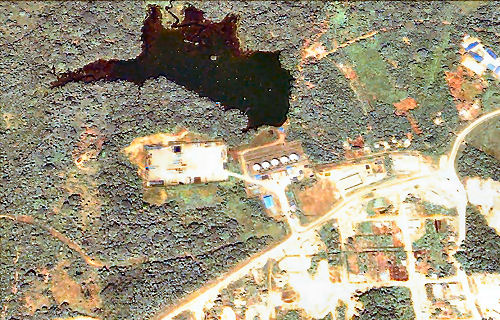
Antonia Juhasz is an oil and energy expert, author and investigative journalist. She is the author of three books related to the oil industry and the influence of multinational oil companies in international politics. Juhasz is a well-known critic of Chevron, having conducted years of extensive investigations into its operations, and writing about Chevron in each of her three books and in dozens of articles. In one of her earlier books, The Bush Agenda: Invading the World, One Economy at a Time, Juhasz exposed the use of corporate globalization policy as a weapon of war during the Bush administration, and the role that major corporations, like Chevron, played in the creation of this agenda.
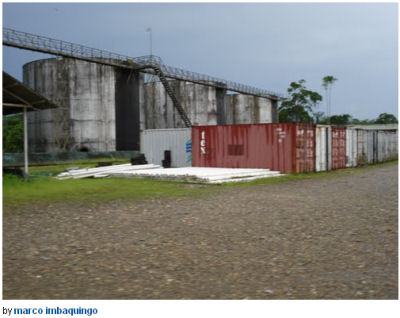
Juhasz will visit one of the contaminated areas in the province of Sucumbios, where actor Danny Glover, visiting last week said that “Chevron must be held accountable” for the damages. Many of these oil pits were operated exclusively by Chevron-Texaco. Juhasz will be able to confirm first-hand a fact that Chevron fails to admit in its press releases, that during its operations in Ecuador, Chevron’s predecessor, Texaco, used substandard and outdated methods to handle the toxic wastes, and systematically dumped over 18 billion gallons of wastewater and oil by-products into unlined pits, that subsequently caused the contamination of the soil, rivers, streams and groundwater in the areas where the company operated.
In February of 2011, Ecuador’s Superior Court of Nueva Loja issued a judgment (Aguinda v. Chevron No. 2003-0002), ordering Chevron to pay $18.3 billion for damages to the environment and the health of the local communities. Chevron refuses to pay the award claiming that the ruling is illegitimate, and instead has filed a lawsuit in a federal court in New York against the Ecuadorians and their lawyers based on the Racketeering Influenced and Corrupt Organizations Act.

The trial began on October 15 in New York. The judge overseeing the trial, Lewis Kaplan, has been accused by the plaintiffs of bias in favor of Chevron through a petition for Writ of Mandamus, which was filed at the U.S. Court of Appeals. (11-2259) The case is Chevron Corp. v. Donziger et al., case number 2:11-cv-00691, in the U.S. District Court for the Southern District of New York.
Antonia Juhasz is promoted by her PR agency as a regular guest commentator on issues related to the energy industry, appearing on major U.S. TV networks and national radio. They add that "Her writings have appeared in many publications, including The Atlantic, Harper’s Magazine, The New York Times, Washington Post, The Huffington Post, International Herald Tribune, Rolling Stone Magazine, and others.
Images here were trawled for from Google Earth. The photos are by Marco Imbaguingo. They do not necessarily relate to the companies mentioned above, but give an idea of the terrain and of the size of some old explorations.
Demographers Bob Birrell and Ernest Healy of Monash University have released their most recent report, entitled Party for Freedom: ‘Scare Jobs: Migrants or Locals at the end of the Queue?. This damning report highlights the incompatibility of recent and current immigration policies sponsored by both Labor and Liberal governments.
Over 250,000 young people leave school each year. They are then faced with the task of competing with a similar number of those on Working Holiday Maker (WHM) visas, coupled with Australia’s population growth of 1.7% or 370,000 a year (including 214,000 permanent migrants) and a pool of over 1.1 million foreigners (excluding New Zealanders) on temporary work visas. This has created a dire situation for locals – especially the young local workers without post-school education.
University educated job seekers are also finding it increasingly difficult to secure employment. For example, Australia has an over-supply of accountants, and despite this, large numbers of foreign accountants are still being granted work visas.
Table 1 Temporary entrants in Australia as of March 2012 and March 2013
Full Total 92,490 more temporary workers in Australia from March 2012 to 2013, despite rising youth unemployment and heavy net overseas immigration.
Table 1 above details the full extent of temporary entrants and temporary visa holders with work rights in Australia. The 457 and WHM visa categories are rising drastically, taking away employment opportunities from Australians in low skilled service jobs, and the hospitality and construction industries.
There is a lot of misinformation being pushed by self-appointed demographers, government ministers, political parties and vested interests on the “need” for more foreign labour.
Self-appointed KPMG Demographer Bernard Salt is well known for his incorrect statements when commenting on demographics and the cry for ever-increasing levels of immigration. In his recent book, The Big Tilt, he claims: ‘2011 is a break point year. From this year onwards, more baby boomers exit the workforce than generation Ys enter’. The above excerpt from Bernard’s book is propaganda and not statistically correct.
The lack of genuine public discussion on the pressing issue of high levels of immigration, especially third world immigration is adding to our woes. More than ever the nation needs robust public discussion on the matter. Debate needs to come from a broad range of stakeholders, including the Australian workers who are being displaced and retired early due to successive governments’ preference for unsustainable immigration.
The negativity and incompatibility of successive immigration policies have contributed to growing dole queues, while increasing numbers of foreign workers on temporary work visas and new migrants displace Australians in the job market. Regrettably, it seems our government has been shackled to pro-population growth advocates and the lobbying of well-organised special interest groups.
Party for Freedom believes protection of the Australian worker is paramount. The Australian ‘battler’ worker deserves a better deal from our government. It does not make sense to import large numbers of foreign workers on temporary visas or maintain high levels of permanent immigration when real job growth has stalled creating an environment of lost opportunity for local job seekers.
It is time for the Australian government to ‘do the right thing’ and shut the gate on large-scale immigration, so that local workers, especially the young, are protected from the encroaching, foreign, job hungry multitudes.

On Friday 8 November at 11 am Healesville Environment Watch activists will deliver a bill for $61m to VicForests on behalf of the people of Victoria. Please join these environmentalists if you can outside 473 Burke Street - VicForests offices.
 For the sixth year running, the state's native forest logging arm, VicForests, has failed to return a dividend to the people of Victoria.
For the sixth year running, the state's native forest logging arm, VicForests, has failed to return a dividend to the people of Victoria.
This is the sum the state business enterprise is supposed to pay for the privilege of being allowed to log publicly-owned forests.
A review of VicForests' performance prepared for Treasury in 2010 suggested that the company should be able to produce 15% - 20% Return on Equity. On this basis the outstanding amount after 9 years of operation is more than $61 million (at 15% RoE).
An invoice for the outstanding debt of $61 million will be delivered to VicForests' Offices in Melbourne and Healesville at 11:00 am on Friday morning, 8 November.
Please attend if you can!
 The Fast Diet may actually have hit on a way to break people of industrialised countries from their habit of overeating and constantly craving food. It promotes the idea of eating normally five days out of seven. The other two days are non-consecutive days of fasting, when food consumption is kept very low. This is a kind of heresy in societies where people are constantly grazing and obesity is burgeoning. This article suggests that the revolt of the food-slaves may be just the beginning.
The Fast Diet may actually have hit on a way to break people of industrialised countries from their habit of overeating and constantly craving food. It promotes the idea of eating normally five days out of seven. The other two days are non-consecutive days of fasting, when food consumption is kept very low. This is a kind of heresy in societies where people are constantly grazing and obesity is burgeoning. This article suggests that the revolt of the food-slaves may be just the beginning.
Most dieters and the resigned obese will find a certain resonance in the idea that we of the industrialised world have been mis-educated to have an irrational fear of going without food even for one day. This book says that it is okay to hardly eat at all, or even just to drink water, for a day or two at a time. It helps that it is co-written with Mimi Spencer by Dr Michael Mosely, a medical doctor best known for his testing of new medical theories on the BBC. The book bases its theory on the premise that the lifestyle of humans in a more natural state was punctuated with famine as well as feasts. A BBC Horizons documentary preceded the creation of the book. (See further down for link to BBC video.)
Instead of the privations of dieting, this approach helps one to see fasting as a liberation from the chains of almost compulsory regular meals and between-meal grazing, furtive snacking and shameful binging. The book also questions the received wisdom on the importance of breakfasts.
For me this idea of fasting takes care of the intellectual problem of how overeaters might 'abstain' from overeating the way alcoholics abstain from drinking alcohol a day at a time in Alcoholics Anonymous. The Overeaters Anonymous approach suggests abstaining from bad eating habits, from your 'trigger foods', however this does not work very well when all food beyond a few raw or steamed vegetables may be your trigger, when just the act of eating brings on overeating.
Choosing to fast a couple of non-consecutive days a week seems to take care of that problem; you simply don't get started.
As with Alcoholics Anonymous, which promotes the idea that anyone can go without a drink just for one day, this book promotes the idea that anyone can go with an absolute minimum of food one day at a time. The idea is not to then cease to eat at all, but to happily return to one's old habits for the next three or four days, until the time comes for the second fasting day of that week.[1]
The book cites some fascinating scientific work which shows that fasting has many physiological benefits - on mice and men. It sounds almost too good to be true but this way of eating and not-eating can quickly drop blood pressure, cholesterol and raise insulin resistance as well as steadily drop weight. There are some even stronger claims which are well argued, but I will leave you to read the arguments in the book.
No less interesting, however, were the psychological benefits which people felt from being released of the need to overeat, a freedom which seemed to persist into those non-fasting days. Correspondence which the authors have received amounts over time to a social change in how those people deal with food.
The book touches on the commercial pressures that shape our attitudes to food, but it focuses more on empowering us to shut these out with a focused approach to fasting.
I could not help but see that this attitude could be widened to liberate us from other persuasions of the consumerism and growth economy.
As with taking a day off from eating and cooking, I would like to suggest that people start to spend a couple of non-consecutive days a week not buying anything - actively abstaining from purchasing.
The principle behind this idea is that, as we are slaves to continuous impulsive grazing, we are also slaves to continuous impulsive purchasing of stuff.
Immediately stemming from reducing one's involvement with continuous eating and consumption of stuff, is a reduction in driving and shopping. Hours of time and energy can be saved from exhausting navigation of supermarket mazes trying to choose from competing displays, then unpacking everything and putting it away. Ditto for cooking complex meals day in and day out.
Stopping buying non-food 'stuff' which we then spend our lives trying to use or tidy away in ever more crowded lives and living spaces would bring similar benefits. More time, more space, more clarity. The fasting process would also reduce the need for a wardrobe of clothes in various sizes and styles to accommodate inconvenient fluctuations in girth. Thus we would not need to buy so many clothes or have such overstuffed wardrobes and drawers.
I am suggesting that overeating and overpurchasing are both responses to consumerism brainwashing.
Such two day a week stances present a new way of seizing our lives back from the remorseless growth economy.
With a total reduction in food consumption, animal liberationists would see a drop in the rate of killing and consumption of animals and environmentalists would see a reduction in the clearing of forests to grow crops. With the reduction in car-use and cooking and refrigeration we would see a reduction in fuel use.
The fasting and purchasing abstinence days could also be computer-sit-down and internet-free days, and active days, twice a week.
We could apply the same approach to stem the continuous tuning in to radio, television, apps and phones.
It's then easy to see how we might further reduce the amount of stuff our economies churn out and the amount of time we spend working. If we did this then our consumption of finite resources would drop, giving us more time to evolve our economies out of the trap they are marching us all into.
The marketeers would fight back of course. If people succeeded in liberating themselves two days a week from the consumer grind, the growth-lobby would simply try to import more people into industrialised countries, which it is currently doing. But perhaps, with those days we will have seized from the jaws of futile consumerism, we the people might return to community involvement and the associated politics and law, standing up to demand real democracy and against inflicted population and economic growth.
[1] Of course that doesn't work with addictions to alcohol and other drugs which affect dopamine release in the brain for longer periods than 24 hours. So if you are doing abstinence from drugs a day at a time, just keep on abstaining.
 (This article originally published 27 Sep 2013. See also: 'Iceland proved there is a way of dealing with financial crisis in isolated country' of 27 Apr (includes embedded broadcast) and Iceland President accuses England, Holland of financial bullying of 1 Feb 2010 on YouTube.) As Iceland’s banking system went into meltdown at the start of the global financial crisis, it came under enormous pressure from the rest of Europe to accept crippling austerity measures that would have burdened its people for generations to come. And yet the tiny island nation stood up to the European Goliath, defiantly opting for democracy even as it stood on the brink of bankruptcy. What can Iceland teach the world about the power of the people and the rule of law? To discuss these issues, Oksana Boyko, powerful Worlds Apart journalist, is joined by the President of Iceland, Olafur Grimsson. The video inside includes a hilariously black piece of humour in footage of Milton Friedman telling a much younger Olafur Grimsson that his values could only lead to tyranny. Olafur Grimsson argues in retrospect that Friedman led the tyranny of the market which is currently impoverishing the states that do not stand up to the international bankers.
(This article originally published 27 Sep 2013. See also: 'Iceland proved there is a way of dealing with financial crisis in isolated country' of 27 Apr (includes embedded broadcast) and Iceland President accuses England, Holland of financial bullying of 1 Feb 2010 on YouTube.) As Iceland’s banking system went into meltdown at the start of the global financial crisis, it came under enormous pressure from the rest of Europe to accept crippling austerity measures that would have burdened its people for generations to come. And yet the tiny island nation stood up to the European Goliath, defiantly opting for democracy even as it stood on the brink of bankruptcy. What can Iceland teach the world about the power of the people and the rule of law? To discuss these issues, Oksana Boyko, powerful Worlds Apart journalist, is joined by the President of Iceland, Olafur Grimsson. The video inside includes a hilariously black piece of humour in footage of Milton Friedman telling a much younger Olafur Grimsson that his values could only lead to tyranny. Olafur Grimsson argues in retrospect that Friedman led the tyranny of the market which is currently impoverishing the states that do not stand up to the international bankers.Some candobetter readers may be familiar with Melanie Klein's book, The Shock Doctrine, which explored a theory of the impact of the Friedman ideology, in the development of 'disaster capitalism'.
This Milton Friedman ideology is, by the way, the one that the Australian major political parties, the ALP and the Liberal Party, still follow - with privatisation and the market supreme. As Oksan Boyko says, criticism of economic rationalism in elected political circles is a very unusual proposition for the West.
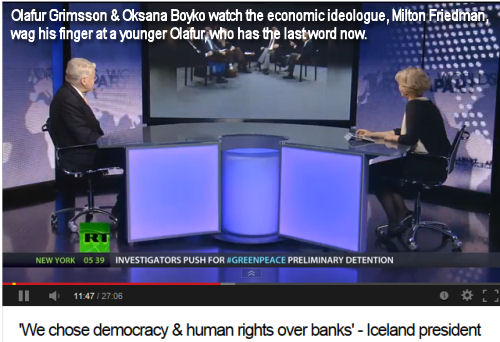
Grimsson notes that it is difficult to find a country more peaceful and secure than Iceland, with a democratic history extending back 1000 years, but when the banks collapsed, the country was faced with riots. He points out that the breakdown of the financial system can threaten democracy: Banks and other economic organs carry an enormous democratic responsibility which has been denied in political economies that give the market primacy.
Should he just surrender to these threats of austerity or let the people decide? He decided to have a referendum - which went against other European states.
Olafur says,
There was a very simple truth at the bottom - what is more important? Democracy and the will of the people, or the interests of the financial markets?
The answer was obvious. What is Europe's most important contribution to the world? Not its economic system, but democracy.
Were other European leaders prepared to sacrifice this one thing that justifies governments. Apparently they were.
Oksan Boyko talks about the "tyranny of the [economic] status quo", asking Grimsson whether he thinks the world has really learned the lessons of the [global financial] crisis and has addressed the underlying reasons?
Grimsson's answer is very interesting, to do with the experiences of Iceland in its resistance to the IMF's demands, which he says were revealed to be illegal. The high officials of the IMF acknowledged that maybe they had learned more from dealing with the Iceland crisis than they expected.
Grimsson also notes that the five Nordic countries in Europe have a combined population of about 20 million and form living experiments that prove that you can have good social welfare but a competitive economy. That you do not have to slash and burn the social fabric as is being done in so many parts of the world. Australia take note; the 5 top democratic economies in Europe have combined a population less than Australia's, but they are more successful and more democratic.
This video was available earlier tonight on RT News on Oksana Boyko's amazing international interview show, but became non-functional. Later it was placed by RT News on Youtube, at the link above, which is http://www.youtube.com/watch?v=qieVZb4Ml9I. The original link on RT was http://rt.com/shows/worlds-apart-oksana-boyko/iceland-banking-system-crisis-366/
The interview covers a lot from a European perspective that values democracy in the light of still vivid memories of the terror of the second world war. Grimsson talks about the responsibility of politicians to listen to their people. He also says that ordinary people have a much clearer sense of what is important than so-called experts.
Grimsson also discusses the role of the UN and the need to engage Russia and China. Boyko sums up well that he is simply suggesting that all countries be treated as equal.


- To extract oil and other minerals from locations where extraction is very difficult, such as in shale formations, or very deep under the sea;
- To mitigate water shortages and pollution issues, using processes such as desalination and long distance transport of food; and
- To attempt to reduce future fossil fuel use, by building devices such as solar panels and electric cars that increase fossil fuel energy use now in the hope of reducing energy use later.
We have long known that the world is likely to eventually reach limits. In 1972, the book The Limits to Growth by Donella Meadows and others modeled the likely impact of growing population, limited resources, and rising pollution in a finite world. They considered a number of scenarios under a range of different assumptions. These models strongly suggested the world economy would begin to hit limits in the first half of the 21st century and would eventually collapse.
The indications of the 1972 analysis were considered nonsense by most. Clearly, the world would work its way around limits of the type suggested. The world would find additional resources in short supply. It would become more efficient at using resources and would tackle the problem of rising pollution. The free market would handle any problems that might arise.
The Limits to Growth analysis modeled the world economy in terms of flows; it did not try to model the financial system. In recent years, I have been looking at the situation and have discovered that as we hit limits in a finite world, the financial system is the most vulnerable part because of the system because it ties everything else together. Debt in particular is vulnerable because the time-shifting aspect of debt “works” much better in a rapidly growing economy than in an economy that is barely growing or shrinking.
The problem that now looks like it has the potential to push the world into financial collapse is something no one would have thought of—high oil pricesclip_image002 that take a slice out of the economy, without anything to show in return. Consumers find that their own salaries do not rise as oil prices rise. They find that they need to cut back on discretionary spending if they are to have adequate funds to pay for necessities produced using oil. Food is one such necessity; oil is used to run farm equipment, make herbicides and pesticides, and transport finished food products. The result of a cutback in discretionary spending is recession or near recession, and less job availability. Governments find themselves in financial distress from trying to mitigate the recession-like impacts without adequate tax revenue.
One of our big problems now is a lack of cheap substitutes for oil. Highly touted renewable energy sources such as wind and solar PV are not cheap. They also do not substitute directly for oil, and they increase near-term fossil fuel consumption. Ethanol can act as an “oil extender,” but it is not cheap. Battery powered cars are also not cheap.
The issue of rising oil prices is really a two-sided issue. The least expensive sources of oil tend to be extracted first. Thus, the cost of producing oil tends to rise over time. As a result, oil producers tend to require ever-rising oil prices to cover their costs. It is the interaction of these two forces that leads to the likelihood of financial collapse in the near term:
- Need for ever-rising oil prices by oil producers.
- The adverse impact of high-energy prices on consumers.
If a cheap substitute for oil had already come along in adequate quantity, there would be no problem. The issue is that no suitable substitute has been found, and financial problems are here already. In fact, collapse may very well come from oil prices not rising high enough to satisfy the needs of those extracting the oil, because of worldwide recession.
The fact that few stop to realize is that energy of the right type is absolutely essential for making goods and services of all kinds. Even if the services are simply typing numbers into a computer, we need energy of precisely the right kind for several different purposes:
- To make the computer and transport it to the current location.
- To build the building where the worker works.
- To light the building where the worker works.
- To heat or cool the building where the worker works.
- To transport the worker to the location where he works.
- To produce the foods that the worker eats.
- To produce the clothing that the worker wears.
Furthermore, the energy used needs to be inexpensive, for many reasons—so that the worker’s salary goes farther; so that the goods or services created are competitive in a world market; and so that governments can gain adequate tax revenue from taxing energy products. We don’t think of fossil fuel energy products as being a significant source of tax revenue, but they very often are, especially for exporters (Rodgers map of oil “government take” percentages).
Some of the energy listed above is paid for by the employer; some is paid for by the employee. This difference is irrelevant, since all are equally essential. Some energy is omitted from the above list, but is still very important. Energy to build roads, electric transmission lines, schools, and health care centers is essential if the current system is to be maintained. If energy prices rise, taxes and fees to pay for basic services such as these will likely need to rise.
For most primates, such as chimpanzees and gorillas, the number of the species fluctuates up and down within a range. Total population isn’t very high. If human population followed that of other large primates, there wouldn’t be more than a few million humans worldwide. They would likely live in one geographical area.
How did humans venture out of this mold? In my view, a likely way that humans were able to improve their dominance over other animals and plants was through the controlled use of fire, a skill they learned over one million years ago (Luke 2012). Controlled use of fire could be used for many purposes, including cooking food, providing heat in cool weather, and scaring away wild animals.
The earliest use of fire was in some sense very inexpensive. Dry sticks and leaves were close at hand. If humans used a technique such as twirling one stick against another with the right technique and the right kind of wood, such a fire could be made in less than a minute (Hough 1890). Once humans had discovered how to make fire, they could use it to leverage their meager muscular strength.
The benefits of the controlled use of fire are perhaps not as obvious to us as they would have been to the early users. When it became possible to cook food, a much wider variety of potential foodstuffs could be eaten. The nutrition from food was also better. There is even some evidence that cooking food allowed the human body to evolve in the direction of smaller chewing and digestive apparatus and a bigger brain (Wrangham 2009). A bigger brain would allow humans to outsmart their prey. (Dilworth 2010)
Cooking food allowed humans to spend much less time chewing food than previously—only one-tenth as much time according to one study (4.7% of daily activity vs. 48% of daily activity) (Organ et al. 2011). The reduction in chewing time left more time other activities, such as making tools and clothing.
Humans gradually increased their control over many additional energy sources. Training dogs to help in hunting came very early. Humans learned to make sailboats using wind energy. They learned to domesticate plants and animals, so that they could provide more food energy in the location where it was needed. Domesticated animals could also be used to pull loads.
Humans learned to use wind mills and water mills made from wood, and eventually learned to use coal, petroleum (also called oil), natural gas, and uranium. The availability of fossil fuels vastly increased our ability to make substances that require heating, including metals, glass, and concrete. Prior to this time, wood had been used as an energy source, leading to widespread deforestation.
With the availability of metals, glass, and concrete in quantity, it became possible to develop modern hydroelectric power plants and transmission lines to transmit this electricity. It also became possible to build railroads, steam-powered ships, better plows, and many other useful devices.
Population rose dramatically after fossil fuels were added, enabling better food production and transportation. This started about 1800.

All of these activities led to a very long history of what we today might call economic growth. Prior to the availability of fossil fuels, the majority of this growth was in population, rather than a major change in living standards. (The population was still very low compared to today.) In later years, increased energy use was still associated with increased population, but it was also associated with an increase in creature comforts—bigger homes, better transportation, heating and cooling of homes, and greater availability of services like education, medicine, and financial servicesclip_image002[1].
How Cheap Energy and Technology Combine to Lead to Economic Growth
Without external energy, all we have is the energy from our own bodies. We can perhaps leverage this energy a bit by picking up a stick and using it to hit something, or by picking up a rock and throwing it. In total, this leveraging of our own energy doesn’t get us very far—many animals do the same thing. Such tools provide some leverage, but they are not quite enough.
The next step up in leverage comes if we can find some sort of external energy to use to supplement our own energy when making goods and services. One example might be heat from a fire built with sticks used for baking bread; another example might be energy from an animal pulling a cart. This additional energy can’t take too much of (1) our human energy, (2) resources from the ground, or (3) financial capital, or we will have little to invest what we really want—technology that gives us the many goods we use, and services such as education, health care, and recreation.
The use of inexpensive energy led to a positive feedback loop: the value of the goods and service produced was sufficient to produce a profit when all costs were considered, thanks to the inexpensive cost of the energy used. This profit allowed additional investment, and contributed to further energy development and further growth. This profit also often led to rising salaries. The additional cheap energy use combined with greater technology produced the impression that humans were becoming more “productive.”
For a very long time, we were able to ramp up the amount of energy we used, worldwide. There were many civilizations that collapsed along the way, but in total, for all civilizations in the world combined, energy consumption, population, and goods and services produced tended to rise over time.
In the 1970s, we had our first experience with oil limits. US oil production started dropping in 1971. The drop in oil production set us up as easy prey for an oil embargo in 1973-1974, and oil prices spiked. We got around this problem, and more high price problems in the late 1970s by
- Starting work on new inexpensive oil production in the North Sea, Alaska, and Mexico.
- Adopting more fuel-efficient cars, already available in Japan.
- Switching from oil to nuclear or coal for electricity production.
- Cutting back on oil intensive activities, such as building new roads and doing heavy manufacturing in the United States.
The economy eventually more or less recovered, but men’s wages stagnated, and women found a need to join the workforce to maintain the standards of living of their families. Oil prices dropped back, but not quite a far as to prior level. The lack of energy intensive industries (powered by cheap oil) likely contributed to the stagnation of wages for men.
Recently, since about 2004, we have again been encountering high oil prices. Unfortunately, the easy options to fix them are mostly gone. We have run out of cheap energy options—tight oil from shale formations isn’t cheap. Wages again are stagnating, even worse than before. The positive feedback loop based on low energy prices that we had been experiencing when oil prices were low isn’t working nearly as well, and economic growth rates are falling.
The technical name for the problem we are running into with oil is diminishing marginal returns. This represents a situation where more and more inputs are used in extraction, but these additional inputs add very little more in the way of the desired output, which is oil. Oil companies find that an investment of a given amount, say $1,000 dollars, yields a much smaller amount of oil than it used to in the past—often less than a fourth as much. There are often more up-front expenses in drilling the wells, and less certainty about the length of time that oil can be extracted from a new well.
Oil that requires high up-front investment needs a high price to justify its extraction. When consumers pay the high oil price, the amount they have for discretionary goods drops. The feedback loop starts working the wrong direction—in the direction of more layoffs, and lower wages for those working. Companies, including oil companies, have a harder time making a profit. They find outsourcing labor costs to lower-cost parts of the world more attractive.
Even apart from the oil price problem, there are other reasons to think that growth cannot continue indefinitely in a finite world. For one thing, we are already running short of fresh water in many parts of the world, including China, India and the Middle East. Topsoil is eroding, and is being depleted of minerals. In addition, if population continues to rise, we will need a way to feed all of these people—either more arable land, or a way of producing more food per acre.
Pollution is another issue. One type is acidification of oceans; another leads to dead zones in oceans. Mercury pollution is a widespread problem. Fresh water that is available is often very polluted. Excess carbon dioxide in the atmosphere leads to concerns about climate change.
There is also an issue with humans crowding out other species. In the past, there have been five widespread die-offs of species, called “Mass Extinctions.” Humans seem now to be causing a Sixth Mass Extinction. Paleontologist Niles Eldredge describes the Sixth Mass Extinction as follows:
- Phase One began when first humans began to disperse to different parts of the world about 100,000 years ago. [We were still hunter-gatherers at that point, but we killed off large species for food as we went.]
- Phase Two began about 10,000 years ago, when humans turned to agriculture.
According to Eldredge, once we turned to agriculture, we stopped living within local ecosystems. We converted land to produce only one or two crops, and classified all unwanted species as “weeds”. Now with fossil fuels, we are bringing our attack on other species to a new higher level. For example, there is greater clearing of land for agriculture, overfishing, and too much forest use by humans (Eldredge 2005).
In many ways, the pattern of human population growth and growth of use of resources by humans are like a cancer. Growth has to stop for one reason or other—smothering other species, depletion of resources, or pollution.
The problem we are running into now is not an easy one to figure out because the problem crosses many disciplines. Is it a financial problem? Or a climate change problem? Or an oil depletion problem? It is hard to find individuals with knowledge across a range of fields.
There is also a strong bias against really understanding the problem, if the answer appears to be in the “very bad to truly awful” range. Politicians want a problem that is easily solvable. So do sustainability folks, and peak oil folks, and people writing academic papers. Those selling newspapers want answers that will please their advertisers. Academic book publishers want books that won’t scare potential buyers.
Another issue is that nature works on a flow basis. All we have in a given year in terms of resources is what we pull out in that year. If we use more resources for one thing–extracting oil, or making solar panels, it leaves less for other purposes. Consumers also work mostly from the income from their current paychecks. Even if we come up with what looks like wonderful solutions, in terms of an investment now for payback later, nature and consumers aren’t very co-operative in producing them.
Consumers need ever-more debt, to make the solutions sort of work. If one necessary resource–cheap oil–is in short supply, nature dictates that other resource uses shrink, to work within available balances. So there is more pressure toward collapse.
Virtually no one understands our complex problem. As a result, we end up with all kinds of stories about how we can fix our problem, none of which make sense:
“Humans don’t need fossil fuels; we can just walk away.” – But how do we feed 7 billion people? How long would our forests last before they are used for fuel?
“More wind and solar PV” – But these use fossil fuels now, and don’t fix oil prices.
“Climate change is our only problem.”—Climate change needs to be considered in conjunction with other limits, many of which are hitting very soon. Maybe there is good news about climate, but it likely will be more than offset by bad news from limits not considered in the model.
This article was originally published on 04.11.2013 on Gail Tverberg's blog, Our Finite World:
Gail Tverberg is an actuary interested in finite world issues - oil depletion, natural gas depletion, water shortages, and climate change. The financial system is also likely to be affected. Gail writes on these issues at Our Finite World.
"Let's prepare ourselves to liberate ourselves from you," Maduro said, proposing a fight against the popular microblog together with Mercosur (the ‘Common Market of the South'), Unasur (Union of South American Nations) and ALBA (Bolivarian Alliance for the Americas), a group of leftist allies of Venezuela.
According to a Thursday statement from the president, Maduro's Twitter account was attacked to spark unrest and suspend the upcoming December 8 elections.
Communications Minister Delsy Rodriguez stated that nearly 6,600 of the leader's Twitter followers disappeared from the president's account within 10 minutes. No details were provided regarding the time of the attack. As of Friday, Maduro had 1.4 million followers.
The opposition has been criticizing the president for obsessing over social media and not paying enough attention to the country's economic problems.
Since his election as Venezuelan president in April, Maduro has spoken about a number of alleged plots against his government - including five attempts on his life.
They invite people to complete their feedback form at http://surveymonkey.com/s/eastwestlink
They are holding information sessions to help the community stay informed and understand the process for making a submission.
When: Thursday, 21 November from 7pm – 9pm
Where: Clocktower Centre, Mt Alexander Road, Moonee Ponds
RSVP: email [email protected]
A further information session will also be held at Flemington Community Centre later in November, in partnership with Flemington Neighbourhood Renewal.
For more details about this visit http://mvcc.vic.gov.au/eastwestlink
They want to get this message out widely. They say, "We will be letting the community know about our online feedback form and our information sessions over the coming weeks, and we’d really appreciate it if you could also let your contacts know too."
How you can find out more?
For more information on the State Government’s East West Link proposal visit http://www.linkingmelbourne.vic.gov.au, call 8562 6800 or email [email protected].
If you have any questions about the online feedback form, information sessions or concerns that you’d like to raise, please contact Gilbert Richardson on [email protected] or 9243 1121.
Source: eastwestlink, Wednesday, October 30, 2013 3:59 PM
 "Friends of Syria" would deny Syrians the right to choose this man to be their President.
"Friends of Syria" would deny Syrians the right to choose this man to be their President.The Friends of Syria—an 11 country coalition ranged against the Syrian government—favors what it calls a "democratic" transition in Damascus. There are multiple problems with this.
The coalition says that the current president, Bashar al-Assad, must have "no role in Syria." How odd that an ostensibly democracy-promoting coalition should dictate to Syrians who it is who can't be president of their country, rather than democratically leaving the question up to Syrians themselves.
The Friends of Syria—an 11 country coalition ranged against the Syrian government—favors what it calls a "democratic" transition in Damascus. There are multiple problems with this.
The coalition says that the current President, Bashar al-Assad, must have "no role in Syria." How odd that an ostensibly democracy-promoting coalition should dictate to Syrians who it is who can't be president of their country, rather than democratically leaving the question up to Syrians themselves.
Equally strange is that half of the coalition members do not support democracy in their own countries. Five of the 11—nearly one-half—are not, themselves, democracies, but are monarchies and emirates (Jordan, Qatar, Saudi Arabia, and the United Arab Emirates) and one, Egypt, is a military dictatorship.
The formal democracies that make up the coalition's other half—the United States, Britain, France, Germany, Italy and Turkey—are not promoting democratic transitions within the territories of their coalition partners, limiting their intervention to Syria alone.
Yet, while Syria has hardly conformed to the Western model of a multi-party democracy, it is not at all the undemocratic dictatorship it has been made out to be. It is not, for example, a Saudi Arabia. It has a parliament. It is anti-colonial and anti-imperialist. And parts of the state, much to the annoyance of the US State Department, remain committed to socialist goals. Presidential elections are scheduled for 2014. Any Syrian, so long as he or she meets minimal basic criteria, is free to run. If Syrians don't want Assad, they'll be free to toss him out then.
On the other hand, coalition member Saudi Arabia is a family business. The Saud family calls the shots. There's no chance they'll be tossed out in elections, since they'll never have any. If Washington were truly interested in cobbling together "Friends of" coalitions to promote democratic transitions in undemocratic countries, it would have long ago put together a Friends of the Saudi People group.
Not that the United States ought to be ranging the globe, foisting its brand of democracy on others. Rather, its selective commitment to democracy promotion (only in countries not under its thumb but not in satellite states), speaks volumes about what US foreign policy is really about—and just how far removed from a meaningful democracy the US version is.
Equally fatal to the idea that the Friends seek democracy in Syria is this: one of its number, Egypt, is ruled by a government installed by the military, after it ousted a democratically-elected government. The charge that Syria's Assad has to go because he is killing his own people (insurgents) hasn't stopped the Egyptian military from killing demonstrators who call for the restoration of their elected government. They deserve the appellation "pro-democracy protestors" more than do the Islamist insurgents who used turmoil in Arab countries to inspire a return to jihad against the secular Arab nationalists in Damascus.
And what of the coalition's formal democracies? All are former colonial powers. They cared not one whit about democracy when they held the greater part of humanity in colonial thrall, including the people who lived in what is modern day Syria. By their actions and duplicity, they've revealed themselves to care as little about democracy in the Arab world as they did when four of them (the Turks, Italians, British and French) ruled Arabs by edict from afar.
Six former colonial powers in a coalition with five tyrannies, telling Syrians who they can't have as president, supporting a group of exiles who wait in the wings for the signal to traipse onto the Syrian stage as Washington's marionette, is hardly the picture of democracy-promoters. If you believe otherwise, then democracy is nothing but a euphemism for imperialism, an emotionally appealing word tossed around as a cover for the very negation of what the Friends of Syria profess to seek.
 Whitehorse Council and WERA joined forces to refuse to agree to amended plans going to VCAT and Deputy President Helen Gibson agreed. So the application has gone back to council. "This is what we have been asking for for years," says Mary Drost of Planning Backlash. "Bring this to the attention of your council and urge them to do the same. The precedent has now been set."
Whitehorse Council and WERA joined forces to refuse to agree to amended plans going to VCAT and Deputy President Helen Gibson agreed. So the application has gone back to council. "This is what we have been asking for for years," says Mary Drost of Planning Backlash. "Bring this to the attention of your council and urge them to do the same. The precedent has now been set."

Geoff White, WERA President, refers to
"the letter that WERA and residents of Everton Grove sent to VCAT when the developer came up with 68 changes and a “ complete redesign” after the initial application for 6 townhouses and a 20 apartment block across 4 blocks in Everton Grove; Surrey Hills was refused a planning permit by Council.
He says,
"When Whitehorse planning officers and Council saw the resident letter asking VCAT to not hear an appeal on the amended plans because of the extent of change they decided to join the Hearing in support of the residents application to VCAT. The practice day Hearing on Friday 25 Oct took 1 hr 15 minutes but the decision of Deputy President is what we required. The developer yesterday advised the parties that they will not proceed on the original planning application to a VCAT hearing listed to start 13 November.
We think this is the first time Whitehorse has opposed amended plans before the scheduled VCAT hearing date."
October 14, 2013.
The Principal Registrar
VCAT - Planning & Environment List
55 King Street
Melbourne, VIC., 3000
Dear Principal Registrar,
Re: VCAT Reference No: P830/2013, for 8, 10, 12 and 14 Everton Grove, Surrey Hills, VIC., 3127.
1 Application to strike out the appeal.
Earlier this year, the Whitehorse Council refused under delegation to grant a permit to Gardencity Australia Pty Ltd to build a four storey 20 apartment and 5 three storey and 1 two storey town houses development on the blocks at 8, 10, 12 and 14 Everton Grove. Subsequently, Gardencity has appealed to the Victorian Civil & Administrative Tribunal (VCAT) against that Council refusal, and in support of their appeal have submitted extensively revised plans for that site.
The plans submitted on October 1, 2013 for consideration at VCAT include:
- a 4 storey apartment block of 26 apartments, an increase of 6 on the 20 listed in the original application;
- four two storey town houses instead of 6 proposed; but
- a total of 30 dwellings on the four sites – an overall 15% increase on the numbers of dwellings proposed previously.
- The plans submitted on October 1, 2013 show a significantly different building configuration and land use to that rejected by the Whitehorse Council.
- The developer has submitted a listing of 68 changes they have made to the proposal rejected by Whitehorse Council.
- The developer has advised (in the ninth point of their 68 advised changes) that
“The design response has been completely revised to reflect the design intent of the new architect.”
These 68 changes are so extensive that the development submitted to VCAT and to the parties to the appeal is that of a new development proposal and not merely changes to the original proposal.
Planning decisions in the City of Whitehorse are the role and responsibility of the Whitehorse Council. The development provided on October 1, 2013 is so significantly different from the one rejected by Whitehorse Council, including its significant increase in dwelling numbers and extensive other changes proposed, that it is a new proposal and one we think should be first considered by that Council.
Accordingly, we respectfully request that VCAT strikes out the appeal P830/2013.
2 Application to VCAT to refuse the substitution of plans
If VCAT decides to strike out the application P830/2013, for 8, 10, 12 and 14 Everton Grove, Surrey Hills, VIC., 3127, this request does not apply, but if VCAT chooses to continue the hearing, the undersigned accordingly respectfully request that the VCAT refuse to allow the substitution of plans.
Our reasons for this request follow directly VCAT’s Practice Note PNVCAT9 [March 2012] which states:
“3 As a guiding principle, amendments should not be used to materially increase the scale or intensity of a proposal or to introduce significant new aspects that have not been considered by the responsible authority or primary decision-maker at first instance.”
As the applicant advises, their proposal of October 1, 2013 has:
1. Increased the number of dwellings in the development by 15% - a material increase in the scale and density of a proposal; and
2. “The design response has been completely revised to reflect the design intent of the new architect.” and so has introduced significant new aspects that have not been considered by the responsible authority or primary decision-maker at first instance.
3. The developer has submitted a listing of 68 changes they have made to the proposal refused by the responsible authority, the Whitehorse Council.
Accordingly, as the plans of October 1, 2013 are a material increase in the scale and density of the plans considered by the responsible authority, substitution should not be permitted.
We understand, as the Practice Note indicates, the appeal can still continue and can consider the original plans that the responsible authority refused.
3 Saving time and resources for all parties
The Practice Note also states that:
“2 Permit applicants sometimes seek to amend an application or the plans that form part of an application. The ability to amend plans introduces certainty to the planning and environmental approval process and saves time and resources of authorities, applicants, objectors and the Tribunal by enabling improvements to be made to a proposal without a new application being required.
Key elements of this principle are that the applicant has made genuine efforts to compromise and improve the development.
We consider the increased density, increased scale, almost unchanged visual bulk, unchanged monolithic appearance of an extensive block in a distinctly different streetscape, retained four storey apartment block, and the overall 15% increase in dwellings do not comply with this principle.
The responsible authority (the Whitehorse Council) and the other parties to the appeal must all commit extensive time, resources and money to review the new proposal. Accordingly, the proposal submitted by the applicant fails to meet the Practice Note’s requirements of introducing certainty by saving time and resources. On these further grounds, the undersigned respectfully request that VCAT refuse the applicant permission to substitute plans for those initially considered by the Whitehorse Council.
Yours sincerely,
West of Elgar Residents Association Inc
[Address and contact details]
[Some changes to formatting for easier reading - limited to emboldening of some headings and phrases]
VICTORIAN CIVIL AND ADMINISTRATIVE TRIBUNAL
ADMINISTRATIVE DIVISION
PLANNING AND ENVIRONMENT LIST VCAT REFERENCE NO. P830/2013
CATCHWORDS
VCAT Practice Note PNPE9 – Amendment of Plans and Applications – application to amend permit application by substituting amended plans – cumulative effect of changes – whether amended plans represent a significantly different proposal
APPLICANT Gardencity Australia Pty Ltd
RESPONSIBLE AUTHORITY Whitehorse City Council
RESPONDENT Janine Dankesreither & Others
SUBJECT LAND 8 - 14 Everton Grove
SURREY HILLS VIC 3127
WHERE HELD 55 King Street, Melbourne
BEFORE Helen Gibson, Deputy President
HEARING TYPE Hearing
DATE OF HEARING 25 October 2013
DATE OF ORDER 29 October 2013
CITATION
ORDER
1 The application by the applicant to amend planning permit application WH/2012/333 by substituting amended plans prepared by Noxon Giffen Architects dated 30 September 2013 is refused.
2 The application by objectors to strike out this proceeding is refused.
3 It will be sufficient compliance with the requirements of clause 24 of VCAT's practice note – PNVCAT2 Expert Evidence for parties to file and serve the expert witness statements upon which they intend to rely at the hearing by no later than 1 November 2013.
Helen Gibson
Deputy President
APPEARANCES:
For Gardencity Australia Pty Ltd Ms Roz Wilson, solicitor and town planner
For Whitehorse City Council Ms Kim Piskuric, solicitor, of Maddocks
For Geoff White – West of Elgan Residents Association Mr G White, in person
For R B Ferguson R B Ferguson, in person
For Elizabeth Meredith & Others Ms E Meredith, in person
For Philip Andrew Jeremy Derham Mr P Derham, in person
REASONS
What is this proceeding about?
1 This proceeding is an application for review under section 77 of the Planning and Environment Act 1987 against the council’s refusal to grant a permit for construction of multi dwellings on the subject land and reduction of visitor car parking. A hearing is scheduled on 13 November2013 for three days. The applicant/permit applicant (Gardencity) has given notice of its intention to amend the permit application by substituting amended plans. The council and objectors oppose the proposed amendment. When there is strong opposition to the substitution of amended plans, it is usually appropriate to resolve the issue before the final hearing to provide certainty for all parties as to the basis on which the Tribunal will make a decision. The purpose of the practice day hearing was to consider whether to amend the permit application.
2 The form of development shown on the plans, which currently form part of the permit application, show five detached, three storey dwellings with a mansard style roof spaced across the full width of the Everton Grove frontage. There is a further two storey detached dwelling with a pitched roof form located behind unit 1 close to the southern boundary of the site. Behind units 2, 3, 4 and 5, is a three storey residential building comprising 20 dwellings with a basement car park. The residential building has a pitched roof form and is set back 3 metres from the rear western boundary of the site. Units 3, 4 and 5 have separate driveway access from Everton Grove. The balance of the units and the residential building are accessed from a common driveway off Everton Grove between units 1 and 2 at the front and between unit 6 and the residential building at the rear.
3 The amended plans show four two storey dwellings with pitched roofs, located across the front of the site fronting Everton Grove. Two of these townhouse units are freestanding and two are attached. At the rear of these dwellings is a three storey residential building with a flat roof profile containing 26 apartments with a basement car park. Entry to the basement is via a driveway parallel to the southern boundary with a landscaping set back of 2 metres. Car parking for the four townhouses is by way of separate crossover for each dwelling from Everton Grove.
4 The council and objectors submit that the amended plans are not in accordance with the spirit or intent of the opportunities offered to amend a permit application under the Tribunal’s Practice Note PNPE9 – Amendment of Plans and Applications.
5 For its part, Gardencity submits that the overall height has been reduced slightly; setbacks along the rear (western) boundary remain the same; other setbacks have been reduced slightly; there has been a slight increase in the footprint of the building of 75m2 but this is not significant or substantial in the context of a site of 2902m2. Gardencity submitted that it was not the number of changes that was relevant but the quality of changes. The redesign of the proposal has been a direct response to the concerns expressed by the responsible authority and objectors. To reject the application to amend the permit application and substitute amended plans would only result in a further permit application to the council and a 12 month delay, which would be unfair to the applicant.
6 Gardencity also said that attempts to amend the plans at the council level pursuant to section 57 of the Planning and Environment Act 1987 had been rejected by the council. It submitted that:
The amended plans should not have been a surprise to Council or the main objectors. At the public meeting on 13/2/13 … Gardencity [said it] would change the plans to address many of the issues raised by Council & objectors based on expert advice, which we have now done albeit through the VCAT process.
If Council had given us a realistic timeframe for Section 57, then we wouldn’t be wasting VCAT's time at a Practice Day. Council rejected our request for maximum three months to provide amended plans. I recall one month being their tolerance…
7 Having regard to this submission, it is relevant to look at the background to the way in which the permit application was dealt with at the council level.
Background to permit application
8 The permit application was lodged on 16 May 2012. The plans initially forming part of the application showed a development of seven townhouses and one three storey building comprising 15 dwellings with basement car park (total 22 dwellings).
9 In June 2012, the council requested further information. An extension to the further information due date was granted in August 2012 with the new due date being 21 November 2012. In its request for further information, the council also provided a preliminary assessment of the proposal and identified a number of planning concerns about a wide range of matters. It advised that council “will not support your application in its current form”.
10 On 19 October 2012, Gardencity responded to the request for further information and submitted amended plans. The council amended the permit application pursuant to section 50 of the Planning and Environment Act 1987 so that the amended plans now form part of the permit application. The council wrote to Gardencity again on 9 November 2012 indicating that it still had concerns about the amended plans.
11 The permit application was advertised and attracted 104 objections. A consultative meeting was held on 13 February 2013, which was attended by 57 objectors.
12 Following the meeting in February 2013, there was further dialog between the council and Gardencity in which Gardencity indicated it wished to submit further amended plans. By email dated 14 February 2013, the council advised Dwayne Singleton of Gardencity that it must lodge a section 57 amendment request by 20 February 2013 indicating timelines in which reviews and amended plans can be expected, and if possible the likely extent of changes. The council also advised that in the event that Gardencity elected not to make a section 57 amendment request, or any substantial changes to the proposal, council would proceed to determination of the application “as outlined at last night’s forum” (ie it would refuse the application).
13 On 15 February 2013, Dwayne Singleton of Gardencity advised the council that a section 57 request could be lodged by next week (ie by 20 February 2013) provided revised plans are submitted within 3 months of the section 57 request being made. The delay was due to the need to refer the project to experienced experts “and the revision of the plans typically involves many meetings and redesign hours”. Mr Singleton also noted that: “As we have not shown the plans to experts, it is impossible to guess the extent of change”.
14 The council responded on 19 February 2013 to say that it was resolved to proceed to determination of the application in its current form. Notice of the council’s refusal to grant a permit was issued on 7 March 2013.
15 The amended plans, which Gardencity now wishes to substitute for the plans forming part of the permit application, have been prepared by architects, Noxon Giffen, whereas the current plans appear to have been prepared in-house by Gardencity Australia Pty Ltd. The amended plans are dated 30 September 2013. Notice of the application to amend the permit application was given on 1 October 2013.
Practice Note PNPE9
16 The Tribunal’s Practice Note PNPE9 – Amendment of Plans and Applications sets out when the practice note applies, procedures to be followed and what considerations the Tribunal will take into account when deciding whether to amend an application to which the practice note applies.
17 The introduction to the practice note states as follows:
2. Permit applicants sometimes seek to amend an application or the plans that form part of an application. The ability to amend plans introduces certainty to the planning and environmental approval process and saves time and resources of authorities, applicants, objectors and the Tribunal by enabling improvements to be made to a proposal without a new application being required.
3. As a guiding principle, amendments should not be used to materially increase the scale or intensity of a proposal or to introduce significant new aspects that have not been considered by the responsible authority or primary decision-maker at first instance.
4. It is also important to give the responsible authority and those potentially affected by amended plans a reasonable opportunity to consider them before a hearing.
5. Plans may be amended following consultation or mediation between the parties, or as a result of improvements suggested by expert witnesses, or to respond to issues raised by the responsible authority or objectors during the permit process.
6. This practice note sets out the procedures to be followed by applicants when submitting amending plans or seeking to revise other aspects of an application; and details the considerations the Tribunal will take, when making a decision whether to amend an application in a proceeding.
18 Clause 22 provides as follows:
22. The decision of the Tribunal to amend an application to which this practice note applies is discretionary. In exercising its discretion, the Tribunal may consider the following matters, as relevant:
(a) the extent and impact of the changes;
(b) whether all parties and potentially affected persons have been given reasonable notice of the application in time to consider the proposed amendment before a hearing;
(c) whether the time limits in this practice note have been complied with and any prejudice to a party or potentially affected person arising from any non-compliance;
(d) whether the amendment improves the proposal or responds to issues that have been raised in the course of the decision making process;
(e) whether the amendment materially increases the scale or intensity of a proposal or introduces significant changes or new aspects that have not been considered by the responsible authority or primary decision-maker at the first instance;
(f) whether the amendment involves the consideration of additional planning controls or policies that were not previously relevant; and
(g) whether any special circumstances would support the amendment.
Should the permit application be amended?
19 The fundamental principle underlying the guidance provided by Practice Note PNPE9 is that amended plans should be an evolution or refinement of the original plans. The substitution of amended plans is not an opportunity to put forward a different proposal.
20 The subject land is a large site with development potential. However, the council and objectors say that the proposed development is too intense and constitutes an overdevelopment of the site for various reasons. Whether the amended plans constitute an overdevelopment of the site is not the issue at this stage. That is a matter which will be determined at the final hearing on the merits of the proposal. At this point, the factors I must consider are whether the amended plans materially increase the scale or intensity of the proposal or introduce significant new aspects that have not been considered by the responsible authority at first instance. Do they constitute an evolution or refinement of the proposal currently the subject of the permit application or do they so alter the proposal that it has become, in effect, a different proposal?
21 Gardencity points to the similarities between the plans. Both sets contemplate a series of townhouses along the frontage of Everton Grove with a three storey apartment building at the rear with basement car parking. The overall height is similar. The boundary setbacks are similar or increased.
22 I acknowledge these points of similarity. However, there are also many points of difference, including the following:
• Architectural expression. The external architectural expression of the two sets of plans is quite different, including roof profile, the general massing of the buildings and patterns of fenestration.
• Footprint. There is a marginal increase in the footprint of the amended plans, but the layout is quite different. The townhouses fronting Everton Grove are decreased in number (from 5 to 4) but they are no longer all detached. Townhouses 2 and 3 are attached thus presenting as a more solid built form to the street. The townhouse at the rear has been deleted, but the residential building has been enlarged and now extends as a solid built form across the entire width of the site at the rear.
• Setbacks. The external boundary setbacks are, in the main, similar or reduced. However, there are numerous changes to internal setbacks between buildings. There are also numerous changes by way of the provision of terraces and retaining walls within the front setbacks of the townhouses fronting Everton Grove and the provision of terraces to the dwellings in the apartment building.
• Layout. There are significant differences to the site layout of the amended plans (as noted above in the context of footprint) and to the internal layout of dwellings.
• The total number of dwellings has increased from 26 to 30.
• Increase in car spaces within basement car park from 24 to 33. The amended plans are not accompanied by an amended traffic report. The site plan for the basement (Drawing No A004) suggests that further detail will be provided in the final traffic report, presumably to be presented as part of expert evidence at the hearing.
• Landscaping. There is no detailed landscape plan accompanying the amended plans. It is noted on the plans and in the list of changes to the development that a new Landscape Concept Plan is being prepared and will be distributed in accordance with practice note PNPE2, ie with the expert evidence report.
• Access. The main access to the basement car park has been shifted towards the southern boundary.
23 In the list of changes to the development circulated by Gardencity with its notice of application to amend the permit application, it states that the design response has been completely revised to reflect the design intent of the new architect. I consider this accurately describes the new set of amended plans – it is a complete revision of design to the point of being a different proposal. Cumulatively, in my view, the number of changes transform the proposal from something that could be described as an evolution or refinement of the current proposal into a new proposal. The new set of amended plans steps over the line of what is acceptable by way of amendment under Practice Note PNPE9 becoming something that is not acceptable and that should properly be the subject of a fresh permit application to the council.
24 I find there has been no diminution of scale or intensity. Whilst Gardencity submits that the amended plans improve the proposal and respond to issues that have been raised by the council and objectors, the extent and significance of the changes and the new aspects they introduce mean that the responsible authority has not had a proper opportunity to consider them at first instance. The changes are so numerous and significant that it is not possible to say whether the amended plans represent an improvement to the proposal or exactly how they respond to issues raised by objectors and the council without the sort of detailed consideration that was undertaken by the council when the permit application was initially lodged.
25 I am not persuaded that the plans should be amended on the basis of Gardencity’s argument that a refusal to substitute the amended plans will disadvantage it by delaying their consideration and that this should be a factor weighing in favour of a decision to amend.
26 I consider that Gardencity has had plenty of opportunity to refine its proposed development in response to the council’s concerns since it first lodged the permit application in May 2012. It has known since June 2012 that the council did not support the proposal and the reasons for this. It has already amended its permit application once at the council stage. It is evident from the email correspondence between council and Mr Singleton of Gardencity in February 2013 that Gardencity had not subjected its plans to any detailed expert scrutiny up to this stage. Its failure to do so or to use an architect to design the proposal was a choice that it made. It was not unreasonable for the council to refuse to grant Gardencity an additional three months for it to redesign the proposal given that Gardencity could provide no indication of the changes it proposed to make. The permit application had been lodged some nine months previously and it had already been the subject of detailed commentary by the council and amendment by Gardencity. Responsible authorities are under an obligation to act as promptly as is reasonably practicable. Under the Planning and Environment Regulations, the prescribed time for making a decision on a permit application by a responsible authority is 60 days , a period well exceeded in the current case. The council was entitled to make a decision on the application it had before it.
27 In any event, it has taken Gardencity well in excess of three months to redesign the proposal. The delay between February 2013, when it made the request for additional time, to the time when the plans were prepared and notice given under Practice Note PNPE9 is in the order of seven months, not three months.
28 In my view, Gardencity has been responsible for many of the delays to date by its slow and inadequate response to council’s concerns and by its decision to redesign the proposal late in the piece, just prior to the hearing at VCAT, rather than earlier when first provided with council’s detailed feedback. I am therefore not persuaded that the additional delay, which Gardencity may suffer if the permit application is not amended by substituting the amended plans, is a factor that should outweigh the application of the principles embodied in Practice Note PNPE9.
29 Finally, it is evident that the amended plans are not the complete set of plans that Gardencity wishes to rely upon. Detailed landscaping plans and traffic/car parking reports have not been provided but are proposed to be introduced by way of expert evidence at the hearing. The Tribunal has previously commented in Savrez Pty Ltd v Stonnington CC that this is inappropriate.
Conclusion
30 My conclusion is that this application to amend the permit application by the substitution of amended plans pushes the boundaries of what is acceptable practice under Practice Note PNPE9. Individual changes to aspects of the overall development proposal, which are reflected in the amended plans, may have been acceptable, but it is the cumulative effect of all the changes that lead to my conclusion that this a significantly different proposal to that considered at first instance by the responsible authority and for which the permit application was made. As such, I determine that the permit application should not be amended by substituting these amended plans.
31 In these circumstances, if Gardencity wishes to pursue the proposal represented by the amended plans it should lodge a fresh permit application with the council. So far as the present proceeding before the Tribunal is concerned, Gardencity has two options. It may proceed to the hearing, which is scheduled on 13 November 2013 for three days, on the basis of the current plans that form part of the permit application, or it may withdraw the proceeding.
Helen Gibson
Deputy President
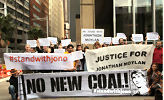 25 year old, coal-mine activist, Jonathan Moylan has made his first appearance in the Supreme Court of New South Wales today, where he entered a plea of not guilty. The ongoing case was moved from the Downing Centre Local Court to the Supreme Court on the request of the prosecution. Supporters stood out the front of court holding placards and banners showing their support for Jonathan and his actions. Mr Moylan was also supported by his parents, and his twin sister.
25 year old, coal-mine activist, Jonathan Moylan has made his first appearance in the Supreme Court of New South Wales today, where he entered a plea of not guilty. The ongoing case was moved from the Downing Centre Local Court to the Supreme Court on the request of the prosecution. Supporters stood out the front of court holding placards and banners showing their support for Jonathan and his actions. Mr Moylan was also supported by his parents, and his twin sister.Maules Creek local farmer Rick Laird, whose property is threatened by Whitehaven’s proposed mine, also attended court with Mr Moylan. The Laird family has owned property in the area for 150 years and are the namesake of the Leard State Forest, two thirds of which will be destroyed if the proposed mines in the area go ahead.
“We’ve been fighting these mines for years, and people are finally starting to hear about it. You’re only given limited ways to challenge mine proposals, and they get approved anyway, even if it means the end of a community. If these mines go ahead, its the end of our livelihoods. We won’t be able to farm the land and we worry about the impact of coal dust on our health,” said Mr Laird.
“The Maules Creek community stands with Jono,” said Mr Laird, out the front of the court house where a large contingent of people from the Gomeroi nation, also joined the vigil.
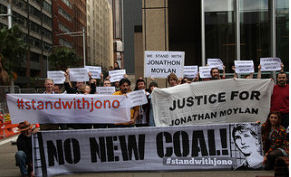
An international campaign has also been growing with Jonathan receiving support from prominent figures such as Noam Chomsky, Bill McKibben and David Suzuki. In recent days there has been coverage in several European papers.
“It is an honor to stand with Jono, to support him in his dedicated and courageous actions to defend all of us against the scourge of coal mining that is destroying the prospects for decent survival, and to protest, vigorously, the harsh sentence for actions that merit praise, respect, and thanks,” said Mr Chomsky.
David Suzuki has recorded a video message, which will be released in coming weeks and says, "Do I support Jonathan Moylan? You bet I do. He's a hero."
Author, environmentalist and founder of 350.org, Bill McKibben said, "Harshly punishing nonviolent action against the coal barons is not just spiteful and mean, it's stupid. Mr Moylan clearly speaks for the future."
In a campaign video that has been widely circulated high profile barrister Brian Walters SC stated, “Jonathan served ANZ shareholders by making them aware their resources are being used unethically."
In January this year, Mr Moylan sent a press release on ANZ letterhead to the ASX stating that the bank would withdraw financial support from Whitehaven’s Maules Creek open cut coal mine on ethical grounds.
Mr Moylan is being prosecuted by the Australian Securities and Investments Commission (ASIC) under section 1041E of the Corporations Act, pertaining to the making of false or misleading statements. He is the first individual to be charged under that section of the Act.
More background here and in the video released by the campaign. You can download a high resolution version here or view on the website: www.standwithjono.org

 550 men decided to leave Moadamiya and surrender to the Syrian Army. All were taken to a rest house and served with dignity. Then 50 at a time were taken to the frightening Air Force Intelligence headquarters for two hours of discussion and registration. They will spend one more night in the rest house and then the majority will be able to go back to normal civilian life. Those who have perpetrated crimes will be kept in this rest house for a rehabilitation period.
550 men decided to leave Moadamiya and surrender to the Syrian Army. All were taken to a rest house and served with dignity. Then 50 at a time were taken to the frightening Air Force Intelligence headquarters for two hours of discussion and registration. They will spend one more night in the rest house and then the majority will be able to go back to normal civilian life. Those who have perpetrated crimes will be kept in this rest house for a rehabilitation period.
It is the FIRST time that we have seen such a thing in Syria.
These matters of facts are UNIQUE in the history of the Syrian conflict. No one entered at the air force security services and went out in two hours unless to the grave! A transformation is ongoing.
Agnes-Mariam of the Cross, Head of the International Support Team for Musalaha (Reconciliation) in Syria.

October 31, 2013
And how the ‘release’ of over 5000 women and children was negotiated and secured by a team led by Mother Agnes Mariam.
While Western media have been talking of the siege of Moadamiya – of a siege imposed on suffering civilians by the ruthless Syrian army – and of the urgent need for intervention to prevent starvation, Mother Agnes has been working steadily with ALL parties to the conflict to negotiate a way out of this deadly confrontation for the innocent civilian population trapped in the suburb of Damascus.
On Tuesday, 29th October, the final stage of the plan was achieved, and all those civilians wishing to leave were able to reach the safety of a government ‘guest house’ in Damascus, where they will stay until new plans can be made when the Syrian army ‘liberates’ Moadamiya from the remaining ‘rebel’ fighters.
This photo reportedly depicts Mother Agnes proceeding into rebel territory under the anxious eyes of those she has left. She is carrying a white flag. "Despite the entreaties of her team, Agnès-Mariam is producing a white flag and adventure beyond the entrance arch, in rebel territory, a no man’s land known for hiding 12 snipers among the deadliest. Members of the team are watching anxiously for her. Her team follows her. Joined by Sister Carmel and two members of her team, Mother Agnès-Mariam is welcomed by the men of the revolution that came without their weapons. Out of the factory they find themselves with women from Mouaddamiyya waiting for their evacuation."
You may read Mother Agnes's account of what has been happening for the last couple of weeks, as well as showing how a remarkably committed and brave single person can change the course of an intractable conflict on the "Step Back Site." This site has the mission of appealing to journalists reporting on the war in Syria to question pro-war statements by politicians.
The site is not in perfect English and some photographs are missing. This is why I did not transcribe it here. I did not want to confuse any of the message, which is one of bravery and day by day negotiations with warlords.
 This year my 8-year-old daughter's school class has been studying “sustainability”. Last term she was all over me like a rash about not wasting water. Unfortunately, I had to explain to her that saving every last drop of water was actually a waste of time, 'The water you save will just let the government bring in more people because it wants to grow the population. It actually makes more sense for you to use as much water as possible because that may slow the government down'. Article by Michael Lardelli [1].
This year my 8-year-old daughter's school class has been studying “sustainability”. Last term she was all over me like a rash about not wasting water. Unfortunately, I had to explain to her that saving every last drop of water was actually a waste of time, 'The water you save will just let the government bring in more people because it wants to grow the population. It actually makes more sense for you to use as much water as possible because that may slow the government down'. Article by Michael Lardelli [1]. Adelaide's population has now grown to a size where coping with the growth has outpaced our capacity to pay. SA's $2 billion desalination plant (costing $130 million per year to run) was built explicitly to cope with population growth and would be unnecessary without it. Then there are the costs of extra hospital beds, congested roads, crowded schools etc. Counterintuitively, these dyseconomies of scale are counted as positives when GDP figures are calculated!
Adelaide's population has now grown to a size where coping with the growth has outpaced our capacity to pay. SA's $2 billion desalination plant (costing $130 million per year to run) was built explicitly to cope with population growth and would be unnecessary without it. Then there are the costs of extra hospital beds, congested roads, crowded schools etc. Counterintuitively, these dyseconomies of scale are counted as positives when GDP figures are calculated!
As a scientist I am used to reality sometimes appearing counterintuitive. The most famous example is Galileo dropping two metal balls of different weights from the leaning tower of Pisa to demonstrate that they would both hit the ground simultaneously. Demography – the study of the structure of human populations – is another area where the obvious answer is not necessarily the correct one. An interesting example of this was Senator Nick Xenophon's insistence before the recent election that he wanted to promote faster population growth in South Australia. Apparently Nick believes that, with SA's population growing at 1% per year, "We're sitting on a demographic time bomb. There'll be fewer taxpayers compared to the rest of the population." Nick appears envious of WA's population growth of more than 3.4% even though this will double WA's population in only two decades! Imagine trying to double a state's infrastructure – hospitals, roads, sewerage, power etc. - in 20 years when the current estimate is that each additional person requires about $200,000 of infrastructure. From where will that money come?
Unfortunately, Nick has been deceived by the notion that it is possible to significantly “youngify” our population through migration. But even pro-migration demographers reject this idea. As demographers McDonald and Kippen stated in a report for the Department of Immigration and Multicultural Affairs in 1999, “Levels of annual net migration [into Australia] above 80,000 become increasingly ineffective and inefficient in the retardation of ageing. Those who wish to argue for a higher level of immigration need to base their argument on the benefits of a larger population, not upon the illusory 'younging power' of high immigration.” At the moment annual net migration is about three times higher than the 80,000 recommended! A 2008 paper by Katherine Betts a sociologist who specialises in Australin demographics shows how Australia's current sky-high rate of population growth could more than double our population by the end of the century (and our water, food and fuel consumption etc.) but make little difference to our population's median age. In fact, if we encourage immigration rather than supporting women to have children we could end up with an older population structure than otherwise! With ideas this counterintuitive it is no wonder that our normally intelligent Senator Nick is confused.
Australia's current rate of population growth is truly exceptional– or 'third world' – depending on your viewpoint. At the moment we are growing at three times the rate of the rest of the OECD. But despite the yawning infrastructure shortfalls that rate is not fast enough for Labor's Bill Shorten who wants to see still higher levels of immigration. The next arrival could “be the next Albert Einstein or a good taxpayer”. But it could just as well be the next crime boss or a welfare recipient. And while the current SA Labor government starts to talk about dismantling our current planning approval system (to make it easier to realise its urban expansion and densification dreams) the leader of the alternative Liberal government wants more incentives to boost our population growth. It's enough to make you bury your head in your hands in despair – or join Stop Population Growth Now.
[1]The author of this article, Michael Lardelli, is senior lecturer in genetics at the University of Adelaide, translator of Prof. Kjell Aleklett's book “Peeking at Peak Oil”, a committee member of Sustainable Population Australia and a member of the management committee of the political party Stop Population Growth Now.
 The Victorian Government is proposing a large development at the Port of Hastings. This will result in a six lane highway with a freight train line in the middle where the current Westernport Highway is. The development will have significant effects on Westernport Bay and the fish nurseries there.
The Victorian Government is proposing a large development at the Port of Hastings. This will result in a six lane highway with a freight train line in the middle where the current Westernport Highway is. The development will have significant effects on Westernport Bay and the fish nurseries there.
Our processes for social decision-making are failing us.
 In modern Australia there is a “Widespread anxiety about the state of politics” and “the only appropriate response is cynicism” (MacKay 1993 pg 176). The problems are not just local but it is only locally that we can hope to make a difference.
In modern Australia there is a “Widespread anxiety about the state of politics” and “the only appropriate response is cynicism” (MacKay 1993 pg 176). The problems are not just local but it is only locally that we can hope to make a difference.
A necessary part of the solution is increasing local control through a shift in the division of power. But to overcome cynicism it needs to be a genuine shift. In Australia we have learned a unique lesson in this regard. In 1900 the federal government was given specific powers with the intention of improving the material circumstances of everyone. These powers related to such sensible responsibilities as: taxation, postage and communication, banking, immigration, external affairs, pensions and matrimonial matters (Clark, 1987). The residual powers: education, health, railways remained with the states (Clark 1987, pg 188). But over 100 years we have seen state powers gradually usurped by federal government due to financial dependence. This dependence arose from a series of gradual changes in the both the size of federal revenues (from around 5% of GDP in the early 1900’s to 30% of GDP by the 1980’s) and proportion (until 1942 income taxes were collected by the states). The evidence of federal power over the states extends to current attempts to effectively take control of education curriculums through the Gonski reforms (I am not arguing whether that is a good or bad thing, I am just pointing out that power seems to lie with those who control the purse strings). As noted by Andrew and Goldsmith (1998) local government has also experienced “an increased use of appointed as distinct from elected bodies as well as increased state or central control of local government activities and finance”. In which case, legitimising local councils constitutionally and strengthening their authority (through referendum) is unlikely to empower citizens locally if those same councils are heavily dependent on federal or state funding (although some believe this could help). The issue of declining democratic representation as a result of appointed authorities is also significant.
One important concern to address is the perceived low level of competence of local leaders and councils. Let me put forward the idea that local leaders are probably no more or less competent than state or federal leaders, in many cases local leadership in councils is the pathway to parliament, with only an election in-between. Decision making at state and federal levels may seem more effective, but I suspect that this is because they have meaningful budgets and real decision making power, thus they are subject to heavy lobbying by various and conflicting organised groups. It is likely this lobbying more than anything else that leads to a higher, but still inadequate, level of informed and conciliatory decision making by state and federal representatives. A shift of power to the local level would presumably lead to a commensurate increase in lobbying and a corresponding increase in the quality of local decisions.
This does not imply that we need abandon the federal system, but rather that we return much power and money to more localised governments. It is only at the local level that the needs of community can be really understood and addressed. And this only if they have both the authority and resources to do so. Furthermore, without major planned reforms this will inevitably occur anyway – as our paralysed state and federal governments become less and less effective at managing our deteriorating circumstances. There is a failure of leadership at the existing state and federal levels. The only strategy they have is to continue development and growth – this will only make the problems worse. The end of the growth based system is now well in sight, and it is not pretty.
In short, we need to face up to the fact that society has changed substantially over the past 100 years, however, our legal and legislative system has not. It is failing and this is reflected in the evident cynicism and lack of confidence as noted above. Unlike the late 1800’s, Australia is now firmly integrated into a globalised trade and political system. So rather than directing our attention towards real or imagined forces that are beyond the ability of citizens and our current governments, to control we need to act locally to help ourselves. And in fact, we are already seeing this occur in many communities across the globe. (eg: local communities banning GMO’s, creating their own currencies and local defence). In case you doubt the ability of strong communities to deal with crises there is good evidence that they can survive even the most dire calamities, as was demonstrated by Cuba’s resilience when the USSR collapsed (for a summary see here). In fact, Cuba’s response demonstrated a case study for division of powers for emergencies: federal responsibility for health, education and food rationing and local responsibility for production and distribution. But Cubans apparently had faith and trust in their government. Is that true of Australians today?
However, there is an answer - communities can take back control. Through a process of local referendums communities can create a new system of regional governments. These governments can replace both state government and local government by combining two or three council areas into a new state. The newly created regional states can then join the Australian federation under the constitutional process for adding new states.
An example of such a new state government would be the combination of Mornington Peninsula shire (LGA) with Frankston city into a new state government called the State of Mornington Peninsula. The new state would have about 270,000 people –slightly less than the state of Victoria had when it was first formed. A proposal for the new State of Mornington Peninsula is available at 8thstate.net.
Creating the State of Mornington Peninsula would lead to immediate significant economic benefits through creation of local jobs and opportunities. Money and jobs that are currently sent to Melbourne would be re-located on the Peninsula as the State of Mornington Peninsula would have its own education department, state and road planning, transport department, courts and police force etc. The flow on effects of this would significantly boost local business and open up very attractive opportunities to the people of Mornington Peninsula State. It is expected that all state systems would be far more responsive to the needs of the people on the Peninsula than the current state services.
In fact, if this process was to conducted across Victoria it would achieve the decentralisation and revitalisation of rural communities that has been discussed and previously attempted by the Victorian State Government over recent decades (see this ABC report).
The conversion of the State of Victoria into a set of smaller regional states can be done via a state referendum. This could result in around 18-20 regional governments and in such a scenario, a coalition of Victorian Governments could supervise and manage the re-organisation of former State of Victoria assets, services and responsibilities.
The creation of one or more regionalised state governments within Victoria would give communities direct control over the natural environment in which they live. For example, communities would have complete control over the use of GMO crops and Coal Seam Gas Fracking.
Thus communities could decide for themselves whether to navigate an energy descent path earlier or later - i.e before or after potentially destroying their farm land and groundwater supplies by fracking.
However, the ability of communities to effectively organise themselves depends on the strength of those communities. Thus regardless of what happens, there is a practical and necessary action every one of us can take: that is to get involved in local community in some manner; whether it be volunteering, attending local meetings; whatever capacity suits you best. This will build social cohesion, and knowing the people in your local community better will certainly help you feel a lot more comfortable, especially in troubled times - which are imminent . We must act now.
Andrew C and Goldsmith M, 1998 “From Local Government to Local Governance - and Beyond” 19(2) International Political Science Review.
Brown L R, 2010 “Plan B 4.0, Mobilizing to Save Civilisation”,W W Norton & Co, p 5. See also, Earth Policy Institute, Providing a Plan to Save Civilisation (Earth Policy Institute) http://www.earth-policy.org/about_epi/
viewed 30 April 2012.
Clark, M 1987 “A Short History of Australia”, Penguin.
MacKay, H 1993 “Reinventing Australia: the Mind and Mood of Australia in the 90s”, HarperCollins.
Recent comments